News Leaf is the Official Journal of Biodynamic Agriculture Australia Ltd
and published quarterly for each season.
Editor Leonie Milne
(02) 6655 0566
PO Box 54, Bellingen NSW 2454 bdnewsleaf@biodynamics.net.au
Proof reading John Hodgkinson
Copy deadlines for News Leaf • Winter ~ 30th April 2013
Send copy/photographs to: bdnewsleaf@biodynamics.net.au in Windows format.
News Leaf Advertising Rates—Increase effective Autumn 2011 issue
Size of Advertisement Price per issue Annual Price for 4 issues (including GST) (including GST)
Quarter Page 12cm(w) x 4cm(h) $66.00 $224.00 ($56.00/issue)
Quarter Page 7.5cm(w) x 10.4cm(h) $66.00 $224.00 ($56.00/issue)
Half Page 12cm(w) x 8.5cm(h) $132.00 $450.00 ($112.50/issue)
Full Page 12cm(w) x 17cm(h) $264.00 $898.00 ($224.50/issue)
All advertising space is available in black and white or colour.
If design and set-up is required, or your ad does not meet size requirements, work will be charged at $38.50 per hour (including GST) and added to your advertising invoice.
OFFICE
Biodynamic Agriculture Australia Ltd
News Leaf
is the official journal of Biodynamic Agriculture Australia Ltd and is published quarterly to coincide with each of the four seasons.
Biodynamic Agriculture Australia Ltd is a not-for-profit company limited by guarantee supporting Australian farmers and gardeners to regenerate the land and produce quality food and fibre.
The objects of the association are to foster, guide and further develop biodynamic farming and gardening in Australia based on indications given by Rudolf Steiner.

Submission of articles for consideration, requests for permissionto reprint, and enquiries regarding the placing of advertisements in News Leaf can be emailed to bdnewsleaf@biodynamics.net.au or, if in hard copy, mailed to the Biodynamic Agriculture Australia Ltd office, attention to ‘The News Leaf Editor’.
Advertising Rates: See inside front cover for details.
News Leaf is printed on Forest Stewardship Council (FSC Australia), certified paper using vegetable based inks. FSC certification ensures products are derived from ethical and ecologically sustainable sources.
Copyright: Reproduction in whole or in part may only occur with the written permission of the editor.
Ph. (02) 6655 0566
PO Box 54 Fax (02) 6655 0565
Bellingen NSW 2454 bdoffice@biodynamics.net.au
ABN 42 588 901 426 www.biodynamics.net.au
Business Manager Karen Knight marketing@biodynamics.net.au
Account Enquiries Leonie Milne bdaccounts@biodynamics.net.au
Preparations Co-ordinator Alan Johnstone bdpreps@biodynamics.net.au
Preparation Orders Please phone, fax or email to office. Orders are posted Monday to Thursday each week. See Biodynamic Preparations and Product List on page 58.
Typeset by Robin Ellis, Macman & Robin, Bellingen NSW Ph (02) 6655 2226 Email: robinellis@westnet.com.au
Printed by Pepperprint, Coffs Harbour NSW Ph (02) 6651 1566 Email: info@pepperprint.com.au
Disclaimer— While every effort is made to publish accurate information, Biodynamic Agriculture Australia Ltd accepts no responsibility for statements made and opinions expressed in this journal. Furthermore, Biodynamic Agriculture Australia Ltd accepts no responsibility for results or perceived results on individual properties as the implementation of the biodynamic techniques is ultimately the responsibility of the individual.
Biodynamic Agriculture Australia Ltd does not necessarily endorse the product or services being offered within advertisements in this magazine. Acceptance of advertisements is at the discretion of Biodynamic Agriculture Australia Ltd.
Cover: Bellinger River in flood Feb 2013—Paul Blainey, Night Fire—wallyir from morguefile.com.au
1 Biodynamic Agriculture Australia Ltd ~ News Leaf #94
News Leaf #94 ~ Biodynamic Agriculture Australia Ltd
Features
7Play of Fire
Hugh Lovel
How do elemental beings relate to weather and fire processes?

12The Biochar Revolution
Paul Taylor PhD
Biochar and Biodynamics –a potent combination.

17Revealing the Hidden Qualities of Equisetum arvense
Hugh J Courtney
All you ever wanted to know about Horsetail in Biodynamics.

26Dioscorea batata
Barbara M V Scott
Steiner's ‘light root’ –an alternative to potato?
30The Biodynamic Message in China
Diane Watkin
Spreading biodynamics in Guangzhou.
33Turmeric –good for almost everything!
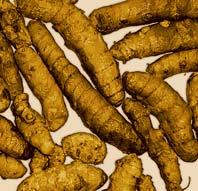
Liuda Macerniene & John Bradshaw
Grow it! Eat it daily!
34The Resilience of Biodynamic Properties to Flood and Drought
Alan Johnstone
Beating the resilience drum again, in the context of weather extremes.
36Into the Realm of the Elemental Beings
Kath Allan
An inspiring and personal glimpse into Kathy's world.
Regulars
4 Welcome to Autumn
5 Letter from the Chair
6 Letters
38dirtgirlworld
40Seasonal Notes
42Preparations Report
46School Fundraiser
48Biodynamic Preparation Balls
50Book Review
Nature Spirits: the Remembrance

51Recommended Reading List

55Membership Form
58Preparations & Products List

3
2
Welcome to Autumn
It’s difficult not to be preoccupied with the weather lately. Summer has been more like the ancient Chinese curse: ‘May you live in interesting times’. This summer has certainly been ‘interesting’ in many parts of Australia, both for its wild wet weather and its extreme heat. In your practice of Biodynamics, you need to feel secure that when conditions dry out and cool down, you may have the techniques to remedy much of the damage caused by excessive rain, even inundation to your soil food web and to your plants, crops and livestock. Horticulturally speaking, the need for infrastructure repair and replanting must be a huge challenge. We hope that this News Leaf brings a little relief from weather extremes that may be afflicting your farm or garden, and lifts your spirits. We continue to bring you some of the best articles which have appeared recently in sister biodynamic journals. Some of them certainly set a high benchmark for our journal to attempt to emulate.
Don’t forget that we would love to include news from you, so keep it in mind to document some biodynamic project, or experience, or experiment or observation, take some photographs and send them in. Diane Watkins’ inspiring account of her China experience in this issue is just what we like to pass on to you.
And a special thanks to Hugh Lovel. He’s such a well of wisdom and his foray into the elemental kingdom we hope you find illuminating and useful. And here’s hoping Autumn settles into that season of mellow fruitfulness for you all.
…The BAA Team.
Call for Nominations to the Board
Nominations from the membership are invited for four two-year positions which fall vacant at the Biodynamic Agriculture Australia Ltd 2013 Annual General Meeting later this year. Please would interested members email the Secretary for a nomination form and Board position information. Completed nomination forms must be received before 4pm, 29 March 2013 . If required, an election will be conducted by postal ballot. 2013-2014 Board members will be announced at the Annual General Meeting.
Secretary email: lskidmore@aapt.net.au
Dear Members,
Weather conditions across eastern Australia over the past few months have been highly variable. Our country continues its pattern of droughts and flooding rains (as well as bushfires in some parts). On our farm, in Western NSW, we have experienced a summer that is quite warm and very dry (with only 18 mm of rain for the year). This is in stark contrast to coastal regions, which have experienced several major flood events. We have been hand feeding sheep and cattle for several months and are looking skyward for rain. Our most recent farm duties have been shearing sheep, fencing, dry sowing oats, joining ewes and rams as well as seed grading.
As you may know, Cheryl Dooley has been working at BAA as our marketing consultant. Cheryl was instrumental in upgrading BAAs website and increasing our social media presence on both twitter (https://twitter.com/BiodynamicAgAus) and Facebook (http://www.facebook.com/BiodynamicAgAu), which has almost 5700 fans. Over the past 20 months, Cheryl created modern packaging and labels for our preparations (which are now being distributed through the retail market); launched our School Fundraising Project (more about this inside); organised Between the Leaves (our online newsletter), as well as creating Partnerships with like-minded groups to further push the benefits of Biodynamics to the wider community. It is with regret that I report that Cheryl has decided to retire and I would like to take this opportunity to thank her for the unwavering effort she has given BAA.
However, as we enter a new year and a new season it is with great pleasure that I am able to introduce Karen Knight, who has been appointed as our new Business Manager. Karen’s role will include the day to day management of the office, as well as filling the role of marketing administrator. Karen has lived in Bellingen for two and a half years and looks forward to serving members.
As our Annual General Meeting is rapidly approaching I would ask all members to consider nominating for positions on the Board of BAA. I would like to particularly encourage members from Victoria, Northern Territory, Tasmania and Western Australia to nominate as we currently have no representatives from these states. I am certainly mindful of the extreme weather conditions (plus bushfires) which may be badly affecting many of our members. I do urge you to give some priority in the recovery phase to putting out preparations. Any biodynamic remediation is worth doing, especially as it contributes to not only recovery, but to resilience.
Best wishes,
Ray Unger, Chairman of the Board

Letter from the Chair
5 Biodynamic Agriculture Australia Ltd ~ News Leaf #94 4 News Leaf #94 ~ Biodynamic Agriculture Australia Ltd
Play of Fire
To: The Editor, News Leaf
I have wondered why some of my seed have been failing since about September. Recently, ‘Old Joh’, who has an organic vegie stall at Orange Grove Markets on Saturday morning, expressed disgust about the lack of germination of some of his crops. He cited some percentages: 11% germination of watermelons, 35% rockmelons, 50% of some others. “See that field there? That should have been full of watermelons”, he thundered at the salesman.
A Sydney biodynamic gardener of long standing questioned if it may be due to the very long and very cold last winter, which I recall as being rather bitter and wet long past the usual springtime appearance. Have any other members noticed seed failure during the last few months?
Diane Watkin, BD Sydney 8.2.2013
Dear Diane
There is little clarity in the scientific community at large on such issues as seeds losing their vitality. On the other hand, there is little awareness in this community of Biodynamics. Seed vitality is one of the issues that gave rise to Biodynamics in the first place. Rudolf Steiner suggested in his Agriculture Course that the earth itself is losing its vitality and that unless a new impulse occurred to restore the earth’s vitality the time was fast approaching when the earth no longer would support life. It was to introduce this new impulse toward life that Steiner proposed the use of remedies that have become known as the biodynamic preparations or biodynamic preps. Application of our Biodynamic Soil Activator—which is compounded using all of the biodynamic preps—will prepare the soil to receive and support the seeds planted in it. Producing our own seed in soils where these biodynamic preparations are well established will further ensure a vital response. Planting with soil activator as a seed treatment can help ensure a vital response as well.
Hugh Lovel, BAA board member.

New Office Hours
We have been running shortened hours during this traditionally quiet time of year and as things start to roll again we’ve reviewed the situation. The majority of our orders arrive early in the week and we believe we can comfortably conduct all our current business in a shorter working week, keeping costs down for members in what is a difficult time for many with the harsh climatic and economic conditions.
Our office hours are now Monday to Thursday 9am to 5pm. Our website http://biodynamics.net.au/ operates twenty four hours a day, seven days a week.
Reflections on the Activities of Elemental Beings
By Hugh Lovel
In ancient times people had a somewhat different, more direct, way of apprehending things. Without the dogmas of modern science as filters of perception they observed certain processes working handin-glove with the physical elements supportive of life: fire, air, water and—most living of all—the earth. Within these elements were processes—the warmth, light, tonality and life associated with fire, air, water and earth—it seemed clear that beings capable of growth, awareness and choice existed within these processes. They called these beings the elementals or elemental beings.
Paracelsus defines Elementals as Spirits of Nature…
Substantial but (for us) invisible beings of an ethereal nature, living in the elements of air, water, earth or fire. They have no immortal spirits, but they are made of the substance of the soul, and are of various grades of intelligence. Their characters differ widely. They represent in their natures all states of feeling. Some are of a beneficial and others of a malicious nature.
Elemental beings have no physical bodies. They live entirely in the ongoing processes taking place with physical things, and when the activities halt the elemental beings involved cease to exist or switch off and become mere potential again. So, though elementals have no physical bodies, processes occur in physical things and elemental beings can and do live in the processes. When ancient peoples saw something in process, such as a forest fire where the forest is burning up, they realized there were beings therein with the potential of rapid growth. These beings very much involved choices, seemingly whimsical, specific though they might be. The burning of a forest is much more than a mechanical process. It goes here, it goes there, almost at whim. It will go upwards as licking tongues of flame where it can. But it can also form balls and shoot across distances and perform all manner of unexplained stunts. It may go almost anywhere, and turn—so to speak—on a dime. What goes on? Why is fire so unpredictable, so whimsical? This is only explained by beings and combi-
7 Biodynamic Agriculture Australia Ltd ~ News Leaf #94
6 News Leaf #94 ~ Biodynamic Agriculture Australia Ltd Letters
nations of beings with awareness and feelings, living within the on-going conflagration process. Obviously winds, also amazingly whimsical, can hold great sway over fires, so fire and air elementals living in the warmth and light processes make joint choices where one or both engage each other.
Ancient peoples had ways of communicating with the various beings around them by entering into the realities of these beings via costumes, dances, chants, songs, timing of events and mind awakening rituals. Were we to realize it our modern ‘eyes in the sky’ weather satellites take the imaginations of ancient medicine workers to levels undreamed of by ancient peoples in regard to their communication with elementals and weather. This is a much superior perspective, and only the extraterrestrials of olden times, recognized by ancient humans as either gods or angels, had such sophisticated viewpoints. These older races, who guided and fostered our evolution, designed our environments and laid down the existing patterns in their present dynamically stable forms.
Rudolf Steiner told us we are at a time in our evolution where those beings—call them angels and archangels if you like—who have guided our development this far are withdrawing and leaving such things as maintaining stable weather patterns to us. This isn’t just something we can do, it’s something we MUST do from henceforth insofar as human civilization is concerned. Otherwise world weather will lapse into chaos—as it seems to be doing. 2012 offered some serious hints of this last northern summer. There was a massive heat wave over the US and Greenland, as now we have experienced in 2013 in Australia. Our former protectors and guides are withdrawing and leaving the organisation of weather up to us.
A hundred years from now the Bureau of Meteorology (BOM) will be where people apply to schedule and ensure timely rainfall, or conversely, clear weather for outdoors events. The engineers working at this Bureau will co-ordinate a wide variety of things on an on-going basis in order to keep world weather operating within certain ranges and parameters. Their forecasts will tend to be reliable enough to cut hay and harvest crops with minimal problems. People will be really ready for this after the next few decades of wilder and wilder weather extremes. But as with so many things today the official ‘bureaus’ and the academic circles they rely upon are uninformed and blind to such things as elementals, just as they are uninformed in regards to secret military research. Thus these present bureaus are incapable of performing this role—which leaves it up to those of us who do know, can see, are willing and are also responsible enough to be relied on for this task. This is an article to explore who may be willing to rise to this task.
For now let us take our BOM (Bureau of Meteorology) print-outs and study them— first so we can see how the elementals are working, and second so as to set up patterns of how we might ask them to work. There are some better, more global, websites—such as Suspicious Observer—that map sun, earth, moon and other planetary data including sunspots and magnetic fields, but everyone can find the BOM site and study it.
The fire elementals (salamanders) work in the rising spirals of warmth, the air elementals (sylphs) work with the winds, and in doing so they link in with the water elementals (undines) who work with tonal waves, particularly sound waves, but also such things as tides and ocean currents. This tone ether is an interesting one because it is the ether of hydrogen, first among material substances—a very important ether. In a lecture I heard by Dennis Klocek he pointed out that this ether, the first amongst the ethers, is also known as the mathematical ether, which was an ‘a hah’ moment for me because it was with hydrogen that Niels Bohr worked out the mathematics of atomic structure. But according to Dennis the Egyptians had the tone ether pegged as the mathematical ether thousands of years ago—another indication that

9 Biodynamic Agriculture Australia Ltd ~ News Leaf #94 8 News Leaf #94 ~ Biodynamic Agriculture Australia Ltd
Photograph by Cedar Rivers from her book The New Frontier: multidimensionality
the Egyptians had some pretty direct connections with the extra-terrestrials that fostered their development. And finally the earth elementals (gnomes) work with fixed frameworks, such as forests and carbon rich soils. Forests have huge stabilizing effects on weather patterns as they cool and condense the air masses flowing overhead. Think what fire elementals can do with forests and that sort of brings it full circle. In the future, forest management is going to have a lot to do with the Bureau of Meteorology—at which point we can seriously look forward to the reclamation of the Sahara (after we have practiced up by reforesting areas in central Australia). Anyone who has gone through the farmed forests of Mississippi, Alabama and Georgia with their marginal soils can appreciate what a resource forests in the interior of Australia might be. It usually doesn’t take good soil to grow good trees, but it does take water. One of the things we can do is look at the correspondences between human realities and elemental realities. Sometimes ancient holistic philosophies lend some guidance, so let us look to astrology, the most ancient of all such philosophies. The tone ether is the entry point, and it corresponds with human feelings. If we want to work into weather patterns we should initiate any new program by starting our cycles in water constellations. Use a biodynamic calendar because it is based on the actual sidereal constellations and not the tropical ‘signs’ in common use for personal astrology. And, lest we forget, we need to get in a good mood and project beneficial feelings. I’ve found that recordings of whales at play were particularly effective in achieving a well-connected feeling for this work, but see what appeals to you—learn, discover. Since we are working with the atmosphere it is important to understand that the atmosphere corresponds to human thought. It is the mental realm. Our thoughts and ideas affect the atmosphere, but, like the wind, they fly everywhere. They can be marshalled by drawing maps and coupling these with pictures of rain along with written intents, as the process of drawing a map anchors our thoughts as forms. To round out this picture, the fire element relates to desire while the earth element relates to the will. These two may combine to the exclusion of thought or feeling— as we all too often see in forest fires. Since there are elemental beings at work here, we can communicate our thoughts to them through our feelings.
During our Australian summers we often have the global record high temperatures. Our salamanders, who live in desire, are loving it and thriving, though they may not be having good relationships with our undines, who live in an element of feeling. Living in a continent of warmth and light, we seem to have plenty of clever fire bugs while needing a better connection with feelings such as gratitude and compassion. Ancient peoples used sound in connection with feeling and I’ve seen various devices

manufactured by indigenous peoples that made sounds like rain. The ancient Vedic culture had mantras as well, just as the American Hopi peoples have rain chants. These days we have all sorts of sound gear and can capture and replay all sorts of sounds from tea kettles going off to floods coming down. We could link moisture with the rising spirals of heat that initiate the beginnings of cloud formation in the morning while playing the sounds of thunder and rain in the afternoon when the clouds get heavy. Slim Spurling (Google Slim Spurling), who lived for a time in Tolga, QLD, had a CD of sounds he claimed ‘tuned’ his environmental harmonizers and were an important part of setting them up to facilitate rain. My wife, Shabari, envisioned a weather ‘toner’, which I built. This was—for me at least—a very creative and engaging way to communicate my thoughts with the elementals over vast expanses ranging from the Hindu Kush to the Polar Vortex over Antarctica using the Daily BOM forecast maps. Who knows how many other avenues exist? Let me suggest being creative—learn, discover, have fun.
Keep in mind that what goes up must come down. Global warming ensures far more evaporation off our equatorial oceans than ever before, and there’s no law that says this has to mean global droughts, Tim Flannery notwithstanding. Yes, evaporation off the land is also accelerated by global warming, but responsible weather engineering would suggest engaging the elementals to ensure, an appropriate part of that global evaporation falls on the Australian interior in a timely fashion. Work on this with enthusiasm and good humour and keep in mind you’ve got a lot at stake. I’m giving some pointers here, but they aren’t the only ones, and I’m sure my wife, Shabari, has more as she’s very cluey about these things too. Good luck. In 2013 our continent burst into fire spectacularly and then moved into spectacular floods. We need more moderation and we need it spread over wider areas with more participation between people and elementals. Therein lies a message for those who have an inner sense for these things.
11 Biodynamic Agriculture Australia Ltd ~ News Leaf #94 10 News Leaf #94 ~ Biodynamic Agriculture Australia Ltd
The Biochar Revolution
 By Paul Taylor PhD
By Paul Taylor PhD
Biochar is fast becoming a household name, so what is it and why is it so important? Well biochar is a fancy green name for charcoal. The old methods for making charcoal were and still are very polluting and unhealthy. The modern method of making biochar, through gasification and pyrolysis, is very clean and the gases and volatiles from the process can even be used for making green electricity or heating water. Biochar is basically a very clean piece of carbon full of holes and is very porous like a sponge, a bit like a high-rise Hilton hotel for aerobic bacteria and fungi. In itself it will make very little change to the soil until bacteria and fungi have populated it. If farmers around the world turned their agricultural waste into biochar alongside a switch to solar and biomass energy, we would very quickly be able to take out the excess carbon we have put into the atmosphere and at the same time make better soil. A win for us and Mother Nature!
Biochar & Biodynamics
Saturating ground-up biochar with a stirred biodynamic preparation (eg Combined Soil Preparation/Soil Activator) before incorporating it in soil creates a rich environment for bacteria and fungi to massively proliferate. Of course it greatly aids this process if we maintain high levels of rotting organic matter both on the soil surface and within the soil profile. But first of all biochar needs to be produced. This can be carried out on a small scale but production can extend to large centralized plants. The added benefit of the latter is that the volatiles can be harnessed for conversion to heat and electricity. In producing biochar we must be careful in using mulching materials or animal feedstock.
Background, Information and Techniques
The following images are a sampling from International Biochar Initiative, www.biochar-international.org
The Book The Biochar Revolution 2010 edited by Paul Taylor PhD, Global Publishing Group. Available from BAA office: $27.00. (Strongly recommended, but a warning: very technical in parts. Ed)
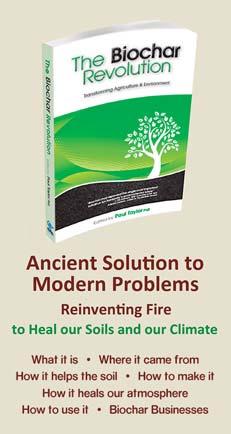
Greatest benefits in degraded, acidic or nutrient-depleted soils.

13 Biodynamic Agriculture Australia Ltd ~ News Leaf #94 12 News Leaf #94 ~ Biodynamic Agriculture Australia Ltd
Some Impacts of Biochar on Soil



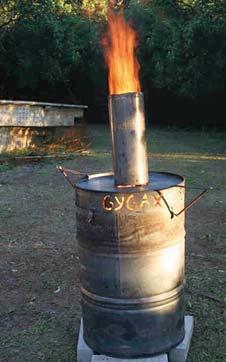
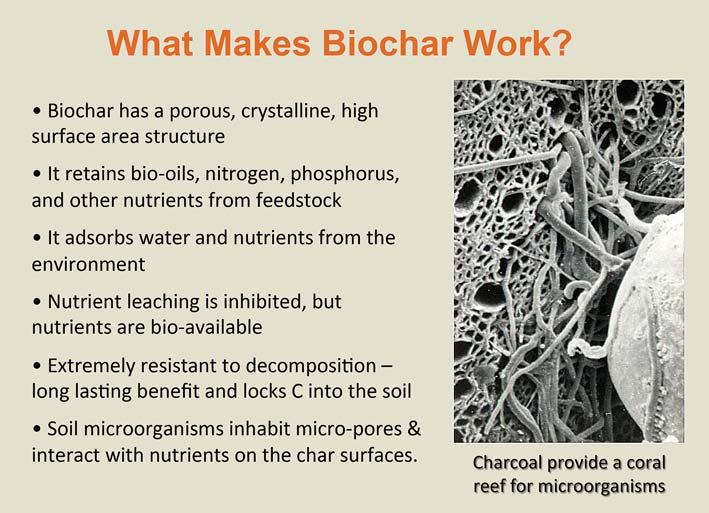
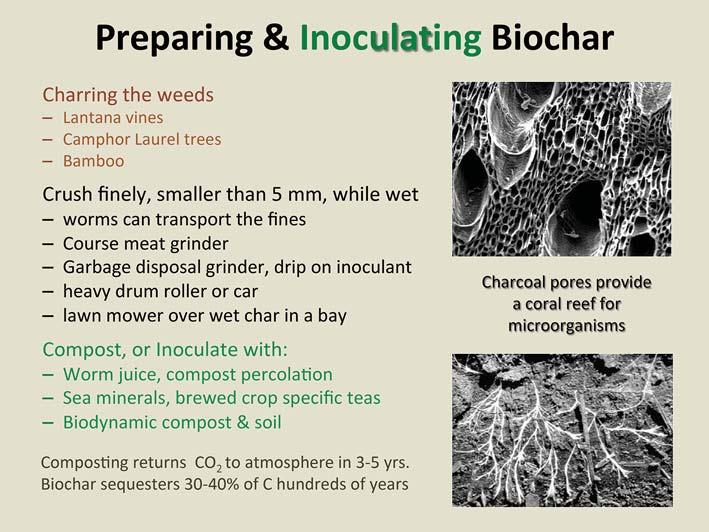
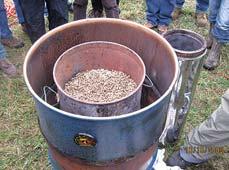
15 Biodynamic Agriculture Australia Ltd ~ News Leaf #94 14 News Leaf #94 ~ Biodynamic Agriculture Australia Ltd
TLUD Gasifiers in Drums
TLUD in 200L drum
Make biochar in your backyard with 2 barrels
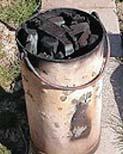


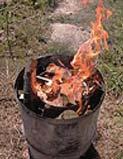
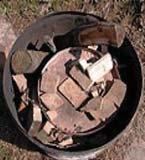


 Inverted Drum method ~ Folke Günther
Inverted Drum method ~ Folke Günther
Revealing the Hidden Qualities of Equisetum arvense
By Hugh J Courtney
Editor’s Note: This article appeared in Star & Furrow Issue 116, Winter 2012. We are grateful for permission to reprint it.
If applied diligently and in a timely manner in Spring, Equisetum helps to combat fungal diseases. In order to understand the nature of the Equisetum plant and how it works, the following extract has been reproduced from the Newsletter of the Josephine Porter Institute, Applied Biodynamics. It is reproduced with their kind permission.
Using Equisetum – Two Approaches
The customary introduction to the use of Equisetum is well illustrated by the basic instructions provided by JPI in the one-page leaflet entitled Brief Directions for the Use of the Biodynamic Sprays, and also the booklet BioDynamic Sprays by H. H. Koepf. The one-page leaflet was inherited by JPI from Josephine Porter in 1984 and the instructions therein were probably originated by Dr. Ehrenfried Pfeiffer shortly after he brought biodynamic agriculture to this country, and may, indeed, have been based on the standard practice in European biodynamic circles. The booklet by Dr. Koepf was based on a pamphlet by Evelyn Speiden Gregg which was likely compiled under Dr. Pfeiffer’s direction in the earliest days of biodynamic agriculture in this country. Thus far, we have not been presumptuous enough to supersede those instructions with our own version, although we have attempted to solicit input from various practitioners with a view to revising instructions for all the spray preparations. As will be seen from the instructions for BD #508, it is identified as a foliar spray. Dr. Koepf specifies that “Horsetail is used against such fungal diseases as mildew, rust, monilia, scab, soil born pathogenic fungi.” He recommends that, “One sprays this tea frequently, especially on garden crops.” Here the implication would seem to be that the Equisetum is regarded also as a foliar spray.
When one examines the book Biodynamic Farming Practice by Sattler and Wistinghausen, which is used as the basic text in a four-year training program for beginning biodynamic farmers in Europe, it is interesting to note that absolutely no reference to identifying it as a biodynamic preparation is made. It is pointedly not

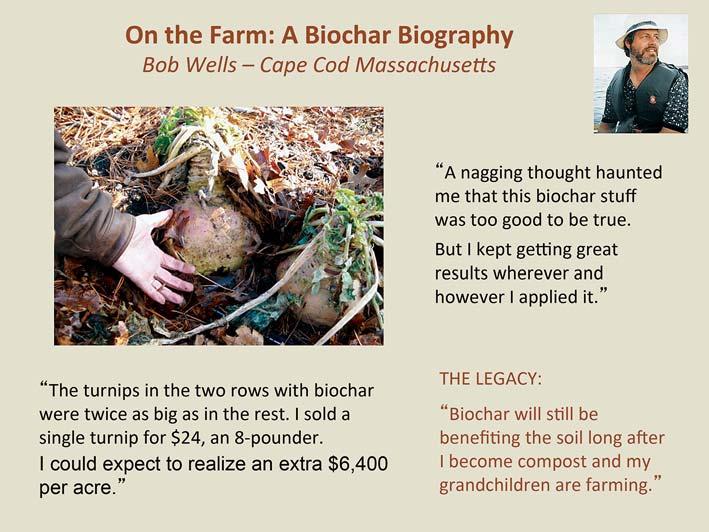
17 Biodynamic Agriculture Australia Ltd ~ News Leaf #94 16 News Leaf #94 ~ Biodynamic Agriculture Australia Ltd
referred to as BD #508 and it appears to be grouped along with several other useful plant-based sprays, such as seaweed, stinging nettle, wormwood and tansy. Immediate use of the tea as a preventative is recommended, although the statement is made that “...stored in a barrel. It will ferment in due course and turn into the liquor, which does not affect its usefulness.” (79) This source also indicates: “Do not add horsetail when stirring Preparations 500 and 501.” (79) In 1997, some eight years after the initial publication of Biodynamic Farming Practice, another booklet, The Biodynamic Spray and Compost Preparations—Directions for Use, jointly compiled by five different European biodynamic practitioners, including the Wistinghausen of the first book, provides a brief one-page mention for Equisetum under the heading “Horsetail (508) Equisetum arvense, a biodynamic plant care Preparation.” The following statements on this page are worth noting:
“The high silica content in this plant can be released either by decoction or by fermentation and be used to regulate fungal growth.”
“In Autumn and Spring this Horsetail tea may be sprayed on the soil to control potential fungal infection and where crops are at risk, directly on the plants as a preventive measure.”

Thus it is only after some fifty to sixty years or more of biodynamic practice that Equisetum is mentioned for application to the soil rather than just to plants, and its preparation by fermentation is endorsed. This delay occurred in spite of Steiner’s very clear statement: “Nevertheless, you have a guiding line, and you will now investigate how equisetum works when you transform it as described, into a kind of liquid manure, and sprinkle it over the fields.” (Agriculture, 118) It is almost transparently evident that ‘liquid manure’ is best arrived at by fermenting the Equisetum; and that it is application to the soil that is meant when we are directed to ‘sprinkle it over the fields’ as one would do if making any kind of manure application.
http://en.wikipedia.org/wiki/File:Equisetum_arvense_foliage.jpg
Although we have had the lectures Steiner has given us for almost eighty-six years, we sometimes do not read them carefully enough. The question to ask is, “Are we choosing to make our own assumptions rather than really paying attention to what he says?”
Here at the Josephine Porter Institute, we have long relied on what we have gleaned from Agriculture of Tomorrow by Lilly and Eugen Kolisko. On pages 82–84 of that work, Lilly Kolisko suggests, when the Moon forces are too strong, the need to “reestablish the right balance with equisetum.” In describing the making of the tea, she states that “It is necessary to boil equisetum for rather a long time. The tea is of a light green colour, and we found it best not to use it immediately, but in a few days’ time, when a certain smell is developing.” On page 84, two pictures derived through the technique of Capillary Dynamolysis are given, one of the fresh tea and one of “Equisetum Tea matured until the characteristic smell develops.” It was clear that the matured or ‘fermented’ Equisetum provided a dramatically more impressive picture of forces or energy at work than does the fresh tea, and we have been using and recommending the fermented Equisetum tea since the late 1980s. Furthermore, based on Steiner’s statement that we “sprinkle it as liquid manure over the fields,” as well as practical application in garden and pasture over a number of years, the fermented tea BD #508 applied as a soil spray following BD #500 in the Spring has proven more effective than fresh tea as a foliar. The preventative role of Equisetum is emphasized with the early season application, although the fermented tea is every bit as effective as the fresh tea when combating fungus that has already appeared. We are inclined to encourage a late fall application to the soil as well. It should be noted that in our experience the ‘characteristic smell’ mentioned by Kolisko is a rather powerful ‘rotten egg’ or hydrogen sulphide smell, which is every bit as powerful as is evident in a fermented stinging nettle brew or liquor. It is most interesting to realize that sulphur is a major anti-fungal agent in orchard and vineyard practice, so the sulphurous character of the fermented version of Equisetum may bring to bear another dimension of anti-fungal forces beyond the level achieved by the fresh tea.
Equisetum in the Context of the Cosmic Forces Within Our Solar System
Throughout the entirety of Lecture Six of the Agriculture Course, Steiner makes frequent mention of ‘Cosmic Forces’. One of the exercises I have pursued in an effort to pay attention to Steiner’s admonishment that we look at the various preparations ‘not as substances, but as forces’, is to imagine which preparation relates to which member of our solar system. My own scheme may differ to a considerable extent from relationships postulated by others. For instance, compared to Lievegoed in The Working of the Planets and the Life Processes in Man and Earth, my interpretation may
19 Biodynamic Agriculture Australia Ltd ~ News Leaf #94 18 News Leaf #94 ~ Biodynamic Agriculture Australia Ltd
Equisetum arvense
Spray BD #508
For Use on Foliage: Standard Instructions
(originating with E.E.Pfeiffer)
Keep dry and in darkness until needed. Part portions may be cooked, keeping same proportions. Fully effective only when used following other biodynamic preparations.
TIME
• During wet, damp or sunless warm weather as preventative of or care for fungus diseases.
• Only during warm time of year.
• Usually in two-week intervals, more frequently in emergency.
• When there is no wind.
• Not when a rain will soon wash it off.
USE
• One portion of BD #508 to one quart water (for cooking).
• Two gallons water for later dilution.
• Same stirring equipment as for BD #500.
PREPARE
• By cooking slowly in covered vessel for twenty minutes.
• Strain and dilute.
• Stir as for BD #500, but only for fifteen minutes.
SPRAY
• With clean sprayer, as for BD #501.
• Using fine mist spray.
• Within a few days when once cooked and diluted.
• Gradually more dilute the more frequently it is used.
also be seen as somewhat simplistic, but it has worked very well for me, due in large part to my previous study of the field of traditional astrology, and my current interest in astrosophy. Of the nine preparations, it is very easy to identify BD #500 with the Earth, and BD #501 with the Sun. Almost everyone who has approached this question assigns the Yarrow Preparation, BD #502, to the planet Venus; the Chamomile Preparation, BD #503, to Mercury; and the Dandelion Preparation, BD #506 to the planet Jupiter. With respect to the remaining principal members of the solar system, Moon, Mars and Saturn, my perception differs substantially from other views that have been expressed. My scheme assigns the Moon to the Oak Bark Preparation, BD #505; Mars to the Stinging Nettle Preparation, BD #504; and finally Saturn, the outermost planet of the visible solar system, to the Valerian Preparation, BD #507. At first glance, one can presume that the solar system assignments are now essentially complete, and need not concern oneself with Equisetum as a bona fide biodynamic preparation; if in fact it is merely something confined to use as an antifungal agent. However, in my reading of other lecture cycles by Steiner, I found a number of intriguing concepts and images. In the first place, Steiner identifies the Lemurian age as the time of the separation of the Moon from the Earth, and also describes the Earth of Lemurian times as one of highly active and flexible growth forces, especially prior to that separation. Geologically, the Equisetum plant family was extremely abundant during this same age which is correlated with the
Mesozoic period by Eugen Kolisko. Numerous fossils of Equisetum plants are found in seams of coal throughout the world, and such plants have been determined to have grown to heights of eighty feet or more and fossil remains have been found in as many as seventy-six layers one on top of the other with clay or shale layers interspersed. Such a finding serves to confirm the possibility of the highly active growth forces mentioned by Steiner.
The Lemurian age is also identified by Steiner as a recapitulation of the ‘Old Moon’ incarnation of the Earth which immediately preceded our present Earth. In further descriptions of Lemurian times, Steiner assigns a very prominent member group of our solar system, which he identifies as the Comet, as belonging to this age. Steiner states that a Comet is born out of the Sun, and dies into the Sun. The Sun can thus be identified with a cosmic/silica force (BD #501) from the center of the solar system, while the Comet can be identified with a cosmic/silica force (BD #508) from the periphery of the solar system. Very specifically, Steiner also describes the Comet as the bearer of the ‘primal feminine force’ which opposes the ‘primal masculine force of the Moon. When one examines the form of the Comet and its pattern of periodic return and then turns to Equisetum arvense and takes a close look at its form, one can see in the physical expression of this plant the same pattern of periodicity in the leaf or frond whorl intervals that are expressed in the Comet. When one further understands that Steiner advises the use of Equisetum as the carrier of a counter force to Moon forces and assigns to the Moon a ‘primal masculine’ character, it is not out of order to understand the Equisetum plant as a carrier of ‘primal feminine’ forces. What can better serve to harness or balance ‘primal masculine’ (Moon/Watery) forces than a ‘primal feminine’ (Comet/Equisetum) force? Thus, if/when the Moon force is either too strong or too weak, Equisetum is the appropriate remedy. The key to the timing of application of Equisetum lies in taking note of whether conditions are too wet (Moon force too strong), or whether conditions are too dry (Moon force too weak). In the former case, one is more likely to achieve the desired results if the application is made when the Moon is in a Fire or Fruit constellation. In the case of a drought, if one makes the application when the Moon is in a Water or Leaf constellation, the probability of some moisture relief is much more likely.
Practical Application of an Abstract Intellectual Theory
All of the theory in the previous section can remain just so much abstract intellectualism unless and until it can be put to some practical use with a dependable consistency of results. Initially, the theory was put to a practical use when I attempted to address a problem of drought in 1988, with the thought that if biodynamic agriculture could
21 Biodynamic Agriculture Australia Ltd ~ News Leaf #94 20 News Leaf #94 ~ Biodynamic Agriculture Australia Ltd
Biodynamic Preparation
Placement for piles over 10 Cubic Yards
• BD#502 and BD#507 are opposite each other (±)
• BD#503 and BD#506 are opposite each other (±)

• BD#504 and BD#505 are placed on top of the pile, alternating with each other (±)
• Fermented BD#508 is placed into holes in the ends, and the middle of the sides.

provide to the environment of the plant or the crop what is needed for its best growth, then by applying the right preparation or preparations in a given situation, one could stimulate the desired results. Since I was not sufficiently astute or clairvoyant to be able to focus on just the right preparation, I resorted to a ‘shotgun’ approach and came up with the ‘Sequential Spray Technique’ using BC (Biodynamic Compound Preparation), followed by BD #s 500, 501, and 508 in a very short period of time. (See Applied Biodynamics, Issue No.6). The initial result was at least a temporary relief of the drought. Even though I had not reached the point in my understanding of applying in only a Leaf/Water period to stimulate moisture, coincidentally, it appeared that my initial effort was actually applied when the Moon was in a Leaf/Water constellation. Subsequent applications that year, although resulting in rain, did not yield as dramatic a moisture relief because at least some of the applications were made during times when the Moon was in a Fruit/ Fire constellation.
A few years later, when my understanding had matured somewhat, during another drought in the early 1990s, when the then governor of Virginia, Douglas Wilder, made
plans to suspend or cancel the deer season because of the extreme fire danger from careless hunters in the woods and forests, a concerted group effort was initiated to stimulate moisture. We were able to coordinate a sequential spray application by six different people at seven different sites, involving farm and garden situations, in both Virginia and North Carolina. The rains came very shortly after this application, and the threatened cancellation or suspension of the deer season was no longer necessary. Since that time, many, many people have employed the Sequential Spray Technique with a high percentage of positive results in attracting beneficial moisture conditions. If nothing else, this technique provides evidence that Equisetum should be regarded as a multi-dimensional preparation, rather than as an afterthought by Steiner limited merely to countering some fungus conditions. In keeping with an effort to broaden the horizon in using Equisetum, I have chosen to use it in the compost pile as though it were a seventh compost preparation. The observed result is that the moisture distribution within the pile tends to be more even throughout with no cold, wet spots or hot spots exhibiting so called ‘fire-fanging’. Such a practice can be readily recommended for adoption in any composting situation (see below).
Another avenue that reveals Equisetum as deserving greater attention and usage is the incredibly significant increase in the count of beneficial fungi in compost teas when it is added to the tea brewer as a standard practice.
BD #508 Fermented Recipe
The following is a slightly modified recipe of the one developed by Lilly Kolisko. Take one unit of shredded Equisetum arvense, which is about eight ounces by volume and one and a half ounces by weight. Bring to a boil in one gallon of water and simmer for one hour. Let cool and transfer to a crock or other storage container with a loose fitting lid. Store this in a cool place, e.g. basement, and allow to ferment ten to fourteen days, until the “characteristic smell” described by Kolisko, develops. Thereafter, strain the remaining herb particles out, fill the tea in a glass jug, and store it in a cool, dark place until ready to use. It can be stored six or more months without losing effectiveness.
To use, add one-half gallon of fermented tea to four and a half gallons water, stir twenty minutes in the biodynamic fashion, and use to treat up to one and a half acres. One unit of horsetail can thereby treat up to three acres with as powerful effect as can be achieved by the fresh tea recipe on only one acre. Ratio for diluting is one part fermented tea to nine parts water. The fermented BD #508 most likely should be applied as a soil spray, whereas the fresh tea version is most likely the form to use as a foliar spray.
22 News Leaf #94 ~ Biodynamic Agriculture Australia Ltd 23 Biodynamic Agriculture Australia Ltd ~ News Leaf #94
Altogether, there is a great deal more to be explored before we have fully fathomed the potential role of Equisetum in our biodynamic practice. The one caveat I would mention, is that all of the recommendations that Steiner makes throughout Lecture Six in the way of weed, insect, and animal pest ‘peppers’ will provide better results if one has previously applied the biodynamic preparations in one form or another to the area of concern before treating with any particular pepper. In particular, it is of prime importance that the Equisetum preparation be applied in order to achieve the optimum results.
Equisetum as Primary Support for “Peppering” and for the Farm Individuality
When we consider various insect and disease pest problems, I would speculate that we will see differences in such problems depending on whether the Moon forces are too strong or too weak. We have a particular movement of the Moon each month which gives us possibilities of a wide difference in the strength of the Moon’s forces. When the Moon is far away from the Earth at apogee, the Moon forces are weaker and when the Moon is quite close at perigee, we have a period when the Moon forces are particularly strong. Closer observation of prevalent insect problems, for instance, might reveal that one would see more flying insects when the Moon forces are weak, and when Moon forces are stronger, we would see more nematode and fungal problems. Orchestrating the particular insect energy that manifests at any given time would be the Moon’s sojourn through the different constellations. Maria Thun’s work seems to suggest that each weed appears to have a relationship to a particular constellation as the Moon travels through the zodiac. When we have to deal with the pestiferous members of the higher animal kingdom, Steiner directs our attention to additional members of the solar system that he states have to do with the forces of reproduction, namely Venus and Mercury, and most especially, the planet Venus when it traverses the constellation Scorpio/Scorpion.
To substantiate the caveat rendered in the previous section with regard to our ability to obtain better results of our ‘peppering’ efforts if the biodynamic preparations NCI are first used, I would call attention to several additional quotes from Steiner. In Lecture Three, p.55, he mentions…
“The silica nature is the universal sense within the earthly realm,...” Earlier, however, on page 38 of Lecture Two, he requests that we, “Look at the Equisetum plant. It has the peculiarity: it draws the cosmic nature to itself; it permeates itself with the siliceous nature. It contains no less than 90% of silicic acid. In equisetum the cosmic is present, so to speak, in very great excess, yet in such a way that it does not go upward and reveal itself in the flower but betrays its presence in the growth of the lower parts.” Finally, on page 118 of Lecture Six, as he is about to give us the remedy
based on Equisetum, which we now refer to as BD #508, he states, “The true force of fertility depends upon the Moon’s influence being normal.”
The several rhythms and movements of the Moon (that is, full moon, new moon, apogee, perigee, descending, ascending, and so forth) provide a full range of possibilities as to strong or weak effects. When further modified by the forces of the particular constellation through which the Moon is traversing, one can be overwhelmed by all the data that one might need to take into account. The agent for ‘normalizing’ the Moon’s influence is none other than Equisetum, which through its silica content brings to bear the Cosmic within the farm individuality. So not only are the Earthly forces, reinforced by an unbridled Moon at play, but the Cosmic forces are there as well. It is BD #501, and especially BD #508 (by virtue of its ‘normalization’ of the Moon’s Earthly energies) which stimulate the sense organs of the farm individuality. Without that stimulation, and with the varying and often abnormal Moon forces, the other members of the solar system cannot bring to bear their powers within that organ of the farm to which they most relate. For instance, the planet Jupiter cannot bring to bear those forces which in the human being relate to the liver. Thus the cleansing ‘liver forces’ within the farm individuality cannot fully function if the Moon forces are not ‘normalized’. Such ‘normalization’ is provided to the farm organism only by the use of Equisetum. Similarly, the other planets cannot exert their forces to the maximum for lung (Venus), digestive organs (Mercury), heart (Sun), and other organ functions relating to Mars, and Saturn. When the biodynamic practitioner relegates Equisetum merely to the more insignificant role of fungus prevention, the full expression of the farm individuality is hindered. It is this picture of the importance of Equisetum that is so compelling to me and which drives my insistence on the absolute importance of using Equisetum arvense, Horsetail Herb, (BD #508) in our biodynamic practice.
References:
1) Lilly Kolisko, Agriculture of Tomorrow (Bournemouth, England: Kolisko Archive Publications, 1978).
2) Rudolf Steiner, Agriculture, trans. George Adams (London: Biodynamic Agricultural Association, 1984).
3) Rudolf Steiner, Art of Lecturing (Mercury Press).
4) H. H. Koepf, Biodynamic Sprays (Kimberton, PA: Biodynamic Farming and Gardening Association, Inc., 1971).
5) Friedrich Sattler, Eckhard von Wistinghausen, Biodynamic Farming Practice trans. A. R. Meuss (Stourbridge, UK: Biodynamic Agricultural Association, 1992).
6) C. von Wistinghausen, W. Scheibe, H. Heilman, E. von Wistinghausen, U. J. König, The Biodynamic Spray and Compost Preparations – Directions for Use (UK: Biodynamic Agricultural Association, 2003).
7) Bernard Lievegoed, The Working of the Planets and the Life Processes in Man and Earth, 1951.
8) Eugen Kolisko, Geology No. 3, “Lemuria – The Mesozoic Age” (Kolisko Archive Publications, 1998).
9) Maria Thun, Matthias Thun, The North American Biodynamic Sowing and Planting Calendar 2010, trans. Bernard Jarman (Edinburgh: Floris Books, 2009).
25 Biodynamic Agriculture Australia Ltd ~ News Leaf #94 24 News Leaf #94 ~ Biodynamic Agriculture Australia Ltd
Dioscorea batata: the Lightroot

 By Barbara M.V. Scott
By Barbara M.V. Scott
Editor’s Note: We are grateful for permission to reprint this article from Applied Biodynamics.
Also known as Cinnamon Vine or Chinese Yam, Dioscorea batata is a truly amazing plant. This wondrous one was spoken of as far back as 1916 by Rudolf Steiner, the founder of biodynamic agriculture, when he pointed out that this one plant, above all, has the ability to store light ether, essential for the energetic life forces needed in the body. He spoke of how this light ether would be vital in the future for human development, particularly as it relates to nutritional quality and forces. In this article, I outline my direct experience with Dioscorea batata.
As a biodynamic farmer and wildlife biologist, I know how critical light is for physiological processes in plants and animals. For many years I have made St. John’s Wort oil, which helps to bring in the necessary light forces for humans during the long winter months in a northern climate, where sunshine can be in short supply. We are eating sunshine, our original food source, during the winter when we eat the fruits and plants that we have put by. Once, that was all that humankind ate—sunshine and air.
If you begin to practice solar gazing, you will notice that your appetite decreases, your spiritual essence rises and you begin to live on light more and more. The friend in California who told me first about solar gazing is now well on her way to becoming a breatharian, i.e. one lives entirely on light and air.
My own journey with the light has led to less dense foods and those that have high nutritional forces. Last spring I noticed that I no longer wanted potatoes, but sweet
potatoes or yams instead. I had first heard mention of Dioscorea batata from a friend in 2008 who was interested in having the plants grown. As my life was rather harried at the time, I took no notice, but then the word lightroot showed up on BDNow, a listserve to which my partner Woody and I belong. This time I knew instantly that I needed to investigate the source. In the back of my mind, I wanted to make some homeopathic medicine from the plant itself. Not quite settled enough to do that, we checked with Uriel Pharmacy (an anthroposophical pharmacy in East Troy, Wisconsin) to see if they could potentize some for us. They did, and we now have a 16x dilution of Dioscorea batata pellets. Gratitude to Mark McKibben, the founder of Uriel, for having some of the powdered form in his fridge from which to make the remedy. It is very subtle, and I have since dubbed it ‘unity medicine’, as I could feel myself move in and out of unity consciousness upon taking the remedy in the morning. I most definitely could feel the light ether within. I am most grateful for this plant with its heart-shaped leaves which stretches long distances to reach the light while the root is swelling underground.
Experiences with Taking Dioscorea batata
We were at a busy time in our lives, about to move yet once again after returning from a fouryear journey into the culture as earth stewards. I was driving between the storage locker, our future home, and Kaslo, British Columbia, where we had been living for nine months. I am familiar with this part of the world, the Kootenays, where I have five generations of ancestors. It is glorious in the summer months with all the wild flowers and spots in nature close to the road. I would stop frequently to take a break from driving at a beach or wooded area to commune with the plants, the trees, and Kootenay Lake. I began to notice that, as soon as my eyes made contact with plants, all friends I have known for years, I could feel the light in me connect directly to the light in the plant or the animal in front of me. It was subtle; I had a lot on my mind, and so was not paying strict attention, just absorbing the feeling sensation and noticing my perceptions. I realized that my sense of humour, despite what was going on around
27 Biodynamic Agriculture Australia Ltd ~ News Leaf #94 26 News Leaf #94 ~ Biodynamic Agriculture Australia Ltd
Young Dioscorea batata vine (2 years) showing yields of bulbils. Older vines make much more… From E. Toensmeier, www.apiosinstitute.org/dioscorea-batatas-chinese-yam
Root grown in deep rich soil in a raised bed. Removable planks on side of bed enable easy harvest of delicate tubers… From E. Toensmeier, www.apiosinstitute.org/ dioscorea-batatas-chinese-yam
me, was heightened. Then this light connection began to happen with people. Wow! What a gift—and what a gift that Steiner spoke about this plant so long ago!
Since recognizing the power of the plant, I have been making this homeopathic miracle available to as many people as possible in my ongoing search for the unified force field, life forces, and a unity consciousness for all. Others are also truly in awe of Dioscorea batata.
One thing that I have noticed since taking this homeopathic remedy is that all fear is quelled. It actually does not seem to even come up anymore. I am not normally a fearful person, but, having been on a four-year journey into the culture, I have had my moments of sheer terror from the sights and sounds of what felt like a world gone mad during our travels across America. I have no fear now. Isn’t that how it is supposed to work: the light moves everything else out of the way and your perceptions totally change?
The second thing that is clearly evident after taking this remedy comes through the memory. Normally, when in good health, I have a photographic memory. Now, with the help of the batata, I have a double photographic memory. When I say double I mean that I can remember where in our totes, some of which have been in storage for over a year, a particular object is. I can recall which tote and where in the tote it is! Not that this will be how this light ether memory evoking can best serve, but clarity and remembrance come in handy when your belongings have been on the move for four years! I also feel the memory and the clarity as a wonderful aid in writing my current book. It helps immensely to choose the words that best fit the feeling sensation or vibration in getting my story across to the reader.
Rudolf Steiner’s statements on Memory and Dioscorea batata
Rudolf Steiner gave a lecture on the 2nd of January, 1916 on the topic of memory: ‘How does memory come about? This is what occurs: the first thing we have to take into consideration is this, that when we met the man five days ago our etheric body experienced certain movements. It is the light part of the etheric body that we are now considering; of course, the other members of the etheric body—the warmth, chemical and life parts also vibrate in sympathy, but it is the light part that we are considering today; I will speak of it therefore as the light body. Our etheric body, then, experienced certain movements … as inner light movements; so that apart from our having perceived the man with our senses, we received the impression (not communicated through the senses) that gave rise to movements in our light body. Thus the whole result of our meeting with the man consisted in our light body
experiencing all kinds of movements. While you stood before the man and spoke to him, your etheric light body was in continual movement. What you said to him, what you felt and thought regarding him, is all disclosed in the movements of your light body. When, several days after, you see this man again, the fresh sight of him stirs your soul, and this movement causes your etheric body, purely because of its laws of continuity, to reproduce the movement experienced five days before, when you met the man and exchanged thoughts with him. Very well, we encounter this man again after five days. The etheric light body, stirred by this meeting, experiences again the same movements which it did at the first meeting…
‘Remembrance is this: the perception from the outer ether of inner etheric movements; the perception from the outer light ether of movements in the inner light body…’
In the Agriculture Course, Steiner also spoke about the ordinary potato in comparison to the Chinese Yam and addressed whether the forces that result from growing food biodynamically would be sufficient to nourish human beings. “On its own this will not be enough” he replied. “The Chinese Yam Dioscorea batata will need to be introduced into Europe so that it can eventually replace the potato as a diet staple. This is the only plant, which can store ‘light ether’ and in the future these light forces will be absolutely vital to human nutrition.”
Barbara M.V. Scott, M.Sc., is a wildlife biologist by training, a biodynamic farmer by calling. See www.soulmedicinejourney.com for her partner Woody Wodraska’s and Barbara’s work in the world. She is currently writing Transmissions of the New Earth, to be published in the Spring of 2011, and is co-creating another node on the etheric web of life with the ongoing work of Aurora Farm.
You may find the wonderful home remedies that Uriel produces at urielpharmacy.com. For those interested in purchasing any 16x homeopathic pellets, contact Barbara@soulmedicinejourney.com.
You can find out more about the growth profile of Dioscorea batata in Bernard Jarman’s article Dioscorea batata – Potato of the Future? in Star & Furrow (No. 106, Winter 2006), the publication of the U.K. Biodynamic Association. Archived issues are available on their website at: www.biodynamic.org.uk/about-bdaa/star-andfurrow/on-line-versions.html.
Editor’s Note: D. batata is a weed! According to the CRC for Australian Weed Management, this species has been recorded as a weed of the natural environment. Be careful.
29 Biodynamic Agriculture Australia Ltd ~ News Leaf #94 28 News Leaf #94 ~ Biodynamic Agriculture Australia Ltd
Magic Water
The Biodynamic Message in China

 By Diane Watkin
By Diane Watkin
In May and June 2012, I was invited to travel to China to present Biodynamics in Guangzhou, two hours north of Hong Kong. The Hairong Waldorf School is situated in a large, bustling city. I had no sooner arrived in town than I was whisked away to a banquet dinner in super-humid conditions wearing Sydney winter gear. The very next day we travelled about 4 hours west into the beautiful green mountains to visit Wang’s farm, 40 acres which he had recently bought, and which he wanted to farm ‘naturally’. He had no English, apart from his mobile translation program, so most of our many discussions were translated by Sophia, who was to become my ‘second skin’ for the rest of my stay.
At the farm we were able to discuss soil and plant problems, with many questions flowing thick and fast between us, with Sophia’s help lively and often humorous discussions took place. The farm had not been worked for a long time, and the orchard and terraced beds were largely overgrown, but with the help of his peasant village workers they were making a start with some vegetables. Wang hopes to show by example a more natural way of farming to the surrounding rice farmers, who use chemicals heavily, as well as provide food for the school, at which he is a parent. These initial discussions provided the foundation of much of the work accomplished during my visit. The school is only about four years old, with three primary classes, six kindergartens, and a waiting list of 100 children. The next few weeks were spent observing, mentoring, teacher training and weekend ‘creative discipline’ seminars, which were very popular with about 45 parents and teachers attending.
We took class 3/4 children back to the farm in my last week for their Farming Main Lesson, over four days, travelling in a large bus and sleeping in a very small village complex, about 20 minutes’ walk away from
the farm through rice paddies. It was wonderful to see blue sky and the sun, even if it was extremely hot, after the grey polluted skies of Guangzhou. Four teachers, children, Sophia and myself, prepared garden beds from rocky clay, young children handling adult-sized mattocks, rakes and spades with enthusiasm and vigour and lots of sweat. They carried endless buckets of water from the small irrigation channel from a mountain spring, and untiringly pulled out large brown plants from other fields for mulching, as well as stirring the Horn Manure 500 and making scarecrows.
A primitive village shed with dirt floors and no doors, served for a farming lesson in English, with a makeshift blackboard consisting of paper clipped to a fibro sheet at about waist level. There was much verse and movement and writing and drawing, watched by the older villagers from the open doorways, with the occasional chook and cat wandering through. William, the class teacher and co-founder of the school, arranged a night-time event with a fire (it looked like it was built in the huge wok which was used to cook our meals), with singing and dancing in Chinese and English of farming and nature songs with movement. We were delighted by the emergence of glowing fireflies when dark took over, and the bright stars made their welcome appearance—for some, even teachers, it was a special event rarely seen in the city’s clouded skies. Afterwards, William leapt over the blazing fire—rather reminiscent of the ancient ‘bull-leaping’ feats of the Minoans! Then encouraged the young boys of the class to try this themselves. Such is the tradition of the Chinese warriors…
Later, I asked the very enthusiastic businessman Wang how many compost heaps he wanted to build. “Los”, he said, proud of his one-word English responses. When I left, he was making four more with the help of the villagers, with Sophia stirring the Valerian in a stainless steel pot.
The farm visit had been preceded by a weekend seminar at the new school, at the time a building site planned for finalisation by September, the start of the school year, adding a new upper class and one more kindergarten. This was attended by nearly fifty people, including farmers, parents, teachers, and a university agriculture department head and four students, now keen to provide a biodynamic course on
31 Biodynamic Agriculture Australia Ltd ~ News Leaf #94 30 News Leaf #94 ~ Biodynamic Agriculture Australia Ltd
Wei (William) Primary School Principle with Diane at a Creative Discipline Workshop.
Farmer Wang also wants to develop fish farming.
my next visit. We had previously seen a copy (in Chinese) of One Man, One Cow, One Planet back at the school, so many were interested in participating in a ‘hands-on’ workshop. Acquiring all the ingredients took much time over three weeks. From this group emerged eight parents who put out the Horn Manure 500 monthly on the new school site, transforming the hard rock, full of building debris, into good soil.
Several parents took home a small bottle of stirred Horn Manure 500. Results were unexpectedly short of miraculous—‘my seeds sprouted overnight’, ‘my half-dead balcony plants stood up straight and healthy’, and more. One non-attendee rushed into the office on Monday morning and wanted ‘some of that magic water’. I thoroughly enjoyed my first encounter with the teachers, parents, staff and farmers. Their friendliness, openness, support and hospitality showed that there is much interest in Biodynamics in Southern China. ■
Turmeric – Good for Almost Everything!
Drought to flood in Gympie
Here is a photo taken at 5.30 this morning of our Dragon Fruit flower. Look at all the bees around it so early in the morning.

We had six months of drought here and were on a limited water supply. We lost a couple of trees in our orchard but were never really without vegetables. Then we had 520mm of rain in three days. It was good that it started off gently, to give the soil a little time to soak some of it up. The garden has bounced back wonderfully and the orchard too. Some of the citrus trees are coming in to full flower again; they just don’t know where they are! I have put out some Soil Activator preparation and next month I will do the 500 again.
I don’t go on Facebook as we only have dialup here and everything is so slow! I am looking forward to the next News Leaf.
Kind Regards to you all, Pleuni Blake
Editor’s note: We welcome such letter from members. Has anyone a farm report or anecdote?
By Liuda Macerniene and John Bradshaw from Biodynamic Growing Magazine No 14.
Turmeric (Curcuma domestica syn Curcuma longa) is a member of the ginger family (Zingiberaceae), native to the tropical forests of south east Asia. It comprises 25% of most curry powders. Turmeric has a wide range of health benefits, and should be used regularly by everyone. Some of its benefits include:
► natural antiseptic and antibacterial
► anti-inflammatory/beneficial for arthritis/natural pain-killer
► natural liver detoxifier
► lowers risk of childhood leukemia
► may lower risk of melanoma and causes existing melanoma cells to die
► combined with cauliflower, helps prevent prostate cancer and stop the progression of existing prostate cancer
► prevented breast cancer in mice spreading to the lungs
► shows promise in slowing Multiple Sclerosis in mice
► may be effective against pancreatic cancer and multiple myeloma
► helps wound healing and skin conditions including psoriasis
► removes amyloid plaque buildup in the brain, thus helping against dementia
Turmeric should be avoided by people with gallstones or bile obstruction, and pregnant women should consult their doctor as it can act as a uterine stimulant.

Turmeric can be added to many dishes. It has a fairly mild flavour and will not dominate. It can be used in the powdered form, or purchased as fresh roots. Grate a fresh root into stir fries, spaghetti sauces, stews etc. and juice a small root along with vegetables and fruits.
Editor’s Note: A detailed rundown on the medicinal and culinary uses of turmeric is given in Isabel Shipard’s How Can I Use Herbs in My Daily Life. We strongly recommend that members consider purchasing this excellent compendium, available from the office for $45.
33 Biodynamic Agriculture Australia Ltd ~ News Leaf #94 32 News Leaf #94 ~ Biodynamic Agriculture Australia Ltd
The Resilience of Biodynamic Properties to Heat and Drought
By Alan Johnstone
Australia is a land of extremes—drought and subsequent wildfires and flooding rains are commonplace. This Summer season is no exception.
While we at Bellingen have not had the extremes experienced in other locations, we have had 40º C plus days followed by overcast and drizzly weather in the 20s, which puts a lot of stress on plants. We had a very dry Spring, and the first two thirds of Summer, with very little moisture in the subsoil.
Having used the biodynamic preparations regularly on my farm since 2005, I notice that pastures and orchard trees bounce back quickly from any extremes of weather.
I can only agree with Shane Joyce’s observations (News Leaf #86) of the results of a long term regular biodynamic regime:
• better water infiltration and retention
• increased pasture diversity
• improved soil structure
• increased grass growth
• better nutrient status of soils
• improved animal health
Strategies for Vegetables in the Heat and Drought
Keep up the application of biodynamic soil sprays monthly, if possible. Water gardens before applying sprays. Where possible apply biodynamic spray to bare soil before mulching. Be careful with the use of Horn Silica in the extreme heat. Use liberal amounts of biodynamic compost when preparing beds.
In the sub-tropics, it is important to protect more tender vegetables from extreme heat. Consider using shade cloth over a portion of your garden—a 60%+ rating is good. I have grown passionfruit and snake beans over my caged vegetable garden, which give some shade protection to the other vegetables. Grow the vegetables that thrive in the heat—sweet corn, sweet potatoes, snake beans, Ceylon spinach, okra, taro, zucchinis, melons, pumpkins etc.
When you have watered deeply, or after a good rainfall event, mulch your garden deeply—min 100mm with pasture hay, straw, grass clippings. This will keep the soil moisture in, keep soil cool and provide food for earthworms and soil food web. You will also not need to water as frequently.
Strategy for Encouraging Rain
Experimentation with the sequential spraying of biodynamic preparations in the USA and Australia since 1987 has resulted in the occurrence of significant rain in drought affected areas in 90% of farms surveyed. What sequential spraying of all of the preparations actually does is to restore a healthy in and out breathing of life energy to an environment that has become stagnant.
To encourage rain, the sequence of application of preparations over a minimum of 1 ha of the farm is:
• Biodynamic Manure Concentrate, stirred for 20 minutes and sprayed out on the first evening
• Horn Silica stirred for 1 hour and sprayed out early the next morning
• Horn Manure stirred for 1 hour and sprayed out that evening
• Fermented Equisetum, stirred for 20 minutes and sprayed out the next morning. This sequence of spraying should occur when the moon is in a leaf/water sign. The effect of sequential spraying appears to be reinforced when done prior to the full or the new moon.
An abbreviated version of sequential spraying is to spray out the combination of Manure Concentrate and Horn Manure in the evening and Horn Silica and Fermented Equisetum the next morning.
Bushfire Recovery
Shane Martin’s study of pasture and soil recovery (NL#92) with the application of biodynamic preparations compared to a control where the preparations were not used point to a dramatic speeding up of recovery under a biodynamic regime.
Conclusion
Regular use of biodynamic soil and atmospheric preparations and biodynamic compost will ensure the maximum resilience of farming or gardening enterprises against extreme weather events, which are becoming more frequent with climate change. They will lead to a quick recovery after natural disasters such as cyclones, floods or fire.
35 Biodynamic Agriculture Australia Ltd ~ News Leaf #94 34 News Leaf #94 ~ Biodynamic Agriculture Australia Ltd
Into the Realm of the Elemental Beings
Elemental beings (nature spirits) often linger quietly in the background of biodynamic practice. For those curious about what a more spiritual view of nature might mean, Taruna College art tutor Kathy Allan describes this unseen world.


The Water Spirits
My knowledge and understanding of the elemental beings has developed over years of study of others’ writings. But also it has arisen as a gardener and nature lover, learning through trial and error to build a relationship with something I feel rather than see.
Primarily my view point of the elemental world is grounded in Rudolf Steiner’s lecture cycle, Man as a Symphony of the Creative Word. But out of this has grown my own perspective and understanding which has taken on its own life and colour.
My impulse is to work with art to bring a deeper awareness of the four elements. By becoming more aware of these physical elements—Earth, Water, Air, Fire—one can begin to penetrate through these elements into the finer etheric world which embodies them. When taken step by tiny step, this journey from the material world into the etheric becomes a natural progression with no great impossible leaps, but many enjoyable surprises.

The Earth Spirits
The elemental spirits of the earth are known as gnomes. They live and work under the moist earth. They work with dedication at their task, which is to bring minerals and sustenance to the roots of the plants. Gnomes are very awake to the world above the earth, through the plants they tend. In this way the gnomes garner all the wisdom the plants learn through their contact with the cosmos.
The elemental spirits that live in the realm of water and where ever the moisture meets the air are known as undines. Their work involves everything to do with liquid. They live in a dreamy water world, flowing in and about the plant, working mainly in the leaves. They weave the substances of air and water together. Above the earth they take over the work of the gnomes, combining and dissolving minerals in their fluid, light-filled domain.
The Air Spirits
The elemental spirits of the air are called sylphs. They live in the realm where the air and the warmth meet. There is a great sympathy between the sylphs and the birds. In a garden full of birds, the sylphs can more easily pour out their quality of of love into their surrounds. The sylphs bear this light and love into the plant to bring about its true form. They work in harmony with undines. They are particularly focused on bringing forth the flowers.
The Fire Spirits
The elemental spirits of fire are called salamanders. They live and work in the realm of warmth. Just as the sylphs have a mysterious and loving relationship with the birds, the warmth beings have a similar relationship with the insects, in particular the bees and the butterflies. Their work is to bring warmth and light into the seed creation part of the plant.
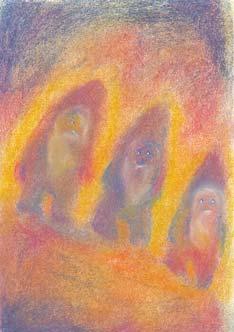
37 Biodynamic Agriculture Australia Ltd ~ News Leaf #94 36 News Leaf #94 ~ Biodynamic Agriculture Australia Ltd
Getting to know Elemental Beings in your garden
The nature spirits are called elemental beings because they work through the four physical elements of earth/mineral, water/moisture, air/light and warmth/fire. A specific and different type of nature spirit works through each of these four elements. Though each group of elemental spirits has their own special work, they are in complete harmony in their interactions with each other, as they endeavour to bring about the creation of the plant world.
Two ways l work with the Elemental Beings in my garden
As I look about when I am gardening I name the elemental beings… here in the earth, the gnomes are toiling… here in the leaves, the undines are weaving… here in the flower, the sylphs are playing… here in the seed, the fire spirits are creating… By continually affirming their presence, an awareness grows and over time becomes a relationship. At night before sleep, one can allow one’s warmth of heart to ray out over the garden and the day’s work. One can even recite the Lord’s Prayer on behalf of the elemental realm. I find by doing these small remembrances, that help comes and any garden problems are often solved in the most surprising manner. ■
In February, The International Academy of Television, Arts and Sciences announced the nominees for the International Digital Emmy Awards. Across all the categories, only one Australian company got the nod.
You’d guess that they would be a Sydney based, team right? Guess again! Melbourne? Adelaide? Nup. Oh… oK…what about those hoodlums in Brisbane? No! … You’d be forgiven for being a little surprised to find out that the company is based in Whiporie … actually a little north west of Whiporie, to be accurate. And if you dig a little deeper into the memory cells, you may make the connection that dirtgirlworld, that Australian created international hit kids TV show, comes from somewhere in the middle of nowhere Australia….bingo!
That’s right, the mememe headquarters is 57 km from the nearest anything bigger than a milk bar, which is 6km away and where their and dirtgirl’s mail is delivered to a pigeon hole.
Located half way between Grafton and Casino on the far north coast of NSW it is on the very fringe of the groovy rainbow region and known more for tea tree than chai lattes.

dirtgirlworld – dig it all…the digital bits… from mememe productions and with the support of Screen Australia has been nominated in the kids and youth Digital Emmy category, to be announced in April in Cannes, where it will also be showcased at the MIPcube!


Once again the dirtgirlworld team are packing their fancy pants and hitting the red carpet.
You’d think they would be used to it by now but it’s still a bit foreign to the gang who spend their time on big messages for little kids, rather than ‘bigging’ themselves up. But when the news is this good …it needs to be shared.
The winner of our dirtgirlworld Competition this edition is… Tomika of Bolwarra.
To celebrate this wonderful news, we are having a
dirtgirlworldsuper special
For the first 10 people who purchase any dirtgirlworld book from our online store in March, we are giving away a set of 10 dirtgirlworld party invitations and a set of 4 birthday cards. Get online, get your copy of dirtgirlworld and help your kids get into the garden today!
The competition question was: “What creature is on the front of dirtgirl’s scrapbook?” The Answer: A Ladybug. Congratulations Tomika! Your dirtgirlworld scrapbook and journal pack is on its way to you!
Biodynamic Agriculture Australia Ltd ~ News Leaf #94 39 News Leaf #94 ~ Biodynamic Agriculture Australia Ltd 38
Congratulations !
SEASONAL NOTES
Brian Keats’ Monthly Weather Predictions
March:4th-8th:widespread strong winds
12th-14th:cyclone warning for Darwin
25th-28th:cyclone warning for Gulf of Carpentaria
29th:widespread strong winds
Brian predicts an early Autumn
April:26th-30th:strong weather warning with effect of lunar eclipse
May: 10th-13th:weather alert for Northern Australia with solar eclipse
24th-28th:weather alert with lunar eclipse
Peak sunspot activity increases weather’s intensity.
June:23rd – Supermoon (closest to earth this year) causes extreme weather conditions and tides.
Biodynamic Practices
Continue to put out soil and atmospheric sprays monthly if possible before Moon opposition to Saturn. Be sure to include 508—Equisetum/Casuarina teas in atmospheric and soil sprays. This will build maximum resilience on your farm to buffer the effects of extreme weather. If there is a prolonged wet period, try doing a sequential spray in the air/fire signs.
After extreme weather, Maria Thun suggests using fresh Equisetum tea—10gm dried Equisetum in 10 litres water and simmered for 20 minutes sprayed on the plants and the soil in the evening. The next morning she suggests a spray of strongly diluted Stinging Nettle Ferment. Equisetum spray pushes the fungi back into the soil, Stinging Nettle stimulates renewed and healthy growth.
SPRAYING DATES
Using Moon opposition Saturn
Moon opp Saturn dates for spraying biodynamic preparations out: increases soil activity. Also best time to plant seeds out – Moon = fertility and germination and Saturn = form and strong structure.
(Eastern Australian Standard Time)
• March 15-16• April 11-12
• May 8-9• June 4-5
Moon Descending Periods
An alternative spraying time – when the Moon’s influences are working below the earth in the soil
• March 5-18• April 2-15, 29-30
• May 1-12, 26-31• June 1-9, 23-30
Peppering Dates for Weeds
Moon in Leo (Note: when Mercury is in retrograde it interferes with some planetary influences and appears to affect making of peppers.)
• March20-27best on 27th (full moon)
• April19-25best on 25th
• May18-24best on 24th
• June17-23best on 23rd (full moon)
Pre-Ordering Preparations
Have you considered joining an increasing number of members who are taking advantage of our service of pre-ordering their preparations. Leonie will set up our system so that you can receive your regular order of preparations in time for application at Moon opposition to Saturn, either monthly, bi-monthly or quarterly.
Moon opposition to Saturn is when the Moon and Saturn are standing on opposite sides of the earth and their forces are raying into the earth from each direction. The Moon forces bring in the calcium processes which are connected to propagation and growth forms, while the Saturn forces bring in the silica processes which are connected to building up substance in root, leaf and fruit. The balancing effect of these two influences streaming into the earth produces very strong plants from seed sown at this time. Spraying out soil and atmospheric preparations at this time reinforces this strengthening effect, making plants more resilient to weather extremes and pests and diseases.
This makes it easier for staff planning and also is one less thing for busy farmers to have to remember. Your farming enterprise will thank you for this regular attention.
Note: Preparations will be sent by regular mail unless you specify express post when ordering them.
41 Biodynamic Agriculture Australia Ltd ~ News Leaf #94 40 News Leaf #94 ~ Biodynamic Agriculture Australia Ltd
By Alan Johnstone, Preparations Manager

AUTUMN, when the summer grasses have seeded and the daylight are receding, is the traditional time to be applying the biodynamic soil sprays. The other traditional time is Spring, however home gardeners and intensive horticulturalists apply soil and atmospheric preparations much more often, usually monthly during the growing season. The Australian Organic and Biodynamic Standards require that the biodynamic soil preparations are sprayed out a minimum of two times per year. It is essential to also spray out Horn Silica (BD501). This is seen as a balancing spray for the soil spray (BD500) and is applied to the atmosphere above and around growing plants.
Biodynamic compost and biodynamic liquid manures are generally made on-farm by biodynamic farmers. These are the key to the fertility on the farm and the use of biodynamic compost preparations guarantee the optimum breakdown of the compost and the quality of the finished product.
Many of our Farm and Garden members are not ordering biodynamic preparations from us. We would like to identify if there is anything BAA can do to make it easier for our members to buy and apply the biodynamic preparations for the sake of their land and of their health and wellbeing. Please ring or email us if you have any suggestions.
Making and supplying quality biodynamic preparations is a core service of BAA and revenue raised helps to keep us viable.
The No-Dig Method of Incorporating Green Manure Crops into the Soil

The BAA office horn pits have been planted out over the Summer with green manure crops. In one pit I planted ‘parrot mix’ consisting of maize, sunflowers, millet, sorghum and cow peas. In the other pit I planted out the tried and true South American combination—The Three Sisters—maize/sweet corn, pumpkins and running beans (cow peas in this case). The corn forms a structure for the running beans and pumpkin vines to climb on and also helps fix nitrogen as its root exudates feed the soil food web. This combination provides large amounts of biomass, both above and below the soil which, when broken down, provides food for earthworms and other soil organisms to convert to stable humus.

News Leaf #94 ~ Biodynamic Agriculture Australia Ltd 42 Biodynamic Agriculture Australia Ltd ~ News Leaf #94 43 PREPARATIONS REPORT
Above: Parrot Mix and Cow Pea green manure Below: Three Sisters mix
The correct time to incorporate the green manure into the soil is when the majority of the species in the green manure crop are flowering. The leafy tops have not become woody and the rhizobia nodules attached to the legume roots are producing the maximum amount of nitrogen. Using a blade on a brush cutter, the crop is cut down as close as possible to the soil. After leaving the green manure for a day to wilt, run over it with a mulch mower to cut it into smaller pieces. Then scatter worm castings or compost over the mulched green manure—1 wheelbarrow over 42m 2 of
BAA’s horn pit. Spraying out Combined Soil Preparation or Manure Concentrate is vital to assist in the composting process. Now it is time to cover the green manure with 100mm thickness of pasture mulch.
In my experience of using this technique
last year, the green manure had been entirely incorporated into the soil, when the mulch was pulled back six weeks later.
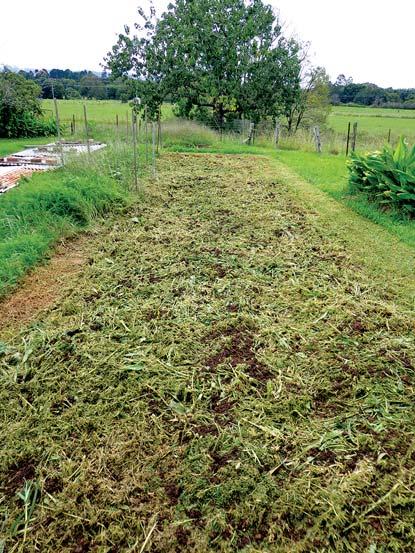

Autumn in the Orchard
Autumn is a time we spray out the biodynamic soil sprays in the orchard. It is also the time for the beginning of the citrus harvest. When citrus has been harvested and before flowering occurs is a good time for pruning, tree pasting and feeding the trees. Cut out any dead wood or broken branches, make sure that the centre of the tree has plenty of air circulation and make sure no branches are overlapping. The tree is now ready for Biodynamic Paste (formally Biodynamic Tree Paste), which is painted over pruning cuts and the trunk and main branches. The Biodynamic Paste is then diluted, strained and sprayed out over the rest of the tree. This protects the leaves from insect attack and nourishes the tree through the leaves. Mow under the trees if they are growing in a grass sward. If you have some good biodynamic compost made, apply about 4 shovelfuls around the drip line of each tree and cover it with mulch. If not, scatter about 2kg of organic chicken manure pellets under each tree. Giving back to the trees in this way after the harvest shows gratitude for the abundance of fruit that they have provided for us.
For deciduous fruit trees that have fruited in spring or summer, pruning can commence in Autumn, followed by feeding and tree pasting as above.
Horn Burial and Preparation Making
Wednesday 3rd April is the day assigned to retrieval of the 2012-13 Horn Silica, Summer Horn Clay and Nettle Preparation at the Biodynamic Office, 25 Nobles Lane, East Bellingen. We will also commence the season’s horn burial and will be burying the Yarrow Preparation (BD502) in stag bladders, the Nettle Preparation (BD504) and Winter Horn Clay. We will also prepare and bury the Chamomile Preparation (BD503) in small intestines and the Dandelion Preparation (BD506). All members of BAA and their interested friends are welcome to attend. Bring old clothes and gumboots if it is wet. Morning tea and protective gloves will be provided, as well as discussion to deepen participants’ understanding of the workings of the Biodynamic Preparations. Proceedings will commence at 9.30am and the day will end at 4pm. Please ring the office on 6655 0566 if you would like to attend for catering purposes.
… Alan
45 Biodynamic Agriculture Australia Ltd ~ News Leaf #94 44 News Leaf #94 ~ Biodynamic Agriculture Australia Ltd
Green manure slashed
Green manure mulched
Our 2013 School Fundraiser is up and running…
BAA was approached last year by a number of schools looking for support in their activities and we felt a school fundraiser could meet both our wish to promote Biodynamics and also assist those schools raise much needed funds.
With our mission to promote the clean, healthy production of food for human and animal consumption, we are passionate about growing things and we are also passionate about children understanding what biodynamic methods are all about. Thus, the Biodynamic Agriculture Australia Ltd School Fundraiser was established.
This month, we are excited to announce that our first school to register is Yallingup Steiner School, located in the Margaret River region, three hours south of Perth in Western Australia. They have approx.100 children at the school and are keen to use and promote biodynamic methods in their school community. Congratulations Yallingup Steiner School, we look forward to supporting you in your fundraising endeavours throughout the year!
If you are associated with a school who might be interested in joining our fundraising program, please send us their contact details or put them in touch with our office. This is a very simple program. No chocolates or sunscreen to buy and keep track of, no walk-a-thons to organise, no money to collect at any time, no freight fees.
This is how it works
1 ► A school official registers the school for the program by completing a form (available on our website (School Fundraiser section under Education and Events or we can send a form out with all the details)
2 ► We then email the school a letter to send to parents and to include in your newsletters.
3 ► Parents/friends of the school, who are interested, join BAA using the unique code provided for that school. For every parent/friend of the school who applies for garden membership, the school receives $5. For every farm membership the school receives $10. The parent/friend (on top of the fact their school receives funding), will receive a free 30g pack of Soil Activator to get them started.
4 ► The money is deposited into the school’s nominated bank account at the end of each quarter.
5 ► The program becomes an ongoing source of funds. This $5/$10 will apply to all renewing members who joined during the scheme, giving the school a continuing source of income if they continue to promote the BAA School Fundraising program. The unique code will change each year.
6 ► The program will even apply to renewing existing members. If the parent/friend is already a BAA member, when the school joins the program, then the school receives $5 or $10 when they next renew, if they use the unique code.
Full details, the form and details of other school gardening programs that might be of interest can be found on the website
http://biodynamics.net.au/education-and-events/school-fundraiser/ alternatively contact Karen on 02 6655 0566 or by email marketing@biodynamics.net.au and we will happily send them all to the right person at your school.
Attention all members – Please note
Your password to access the members area on our website has been changed. You should have received your NEW password via email during the first week in March 2013. Please contact the office if you have any problems accessing the members area.
Website Security
Biodynamic Agriculture Australia Ltd (BAA) would like to reassure our customers purchasing products from our online store, that we are using a very secure shopping cart system.
You will notice that after selecting your purchases, you are redirected to a payment page. On this page you will see https:// instead of http:// in the URL, and there will be a padlock icon. This ensures your credit card information is encrypted and secure.
Our Products Go Via Regular Australia Post
On the subject of ordering we want to reconfirm that our parcels all go via regular Australia Post now. We have done this to keep postage costs down. This means if you are in a hurry, or perhaps live in a remote area and want to receive your goods quickly, you may like to choose the ‘Express’ option when ordering. Postage now starts at only $8.00 including packing and you can find out all the details of freight costs and Australia Post delivery times at… http://biodynamics.net.au/products/shipping-information/
47 Biodynamic Agriculture Australia Ltd ~ News Leaf #94 46 News Leaf #94 ~ Biodynamic Agriculture Australia Ltd
What are Biodynamic Preparation Balls?
Biodynamic Preparation Balls consist of the 5 solid compost preparations—Yarrow (502), Chamomile (503), Nettle (505), Oak Bark (506) enclosed in Manure Concentrate Balls and a vial of liquid Valerian (507). They are used in any product being recycled and fermented such as compost, manure concentrate, seaweed tea, fish concentrate, liquid manures, weed teas, composting toilets, septic tanks and dairy effluent ponds.
Why do we use Biodynamic Preparation Balls?
Biodynamic Compost Preparations bring about an order and balance in the decomposition of the compost material. They also:
► Enhance the proper breakdown of matter into balanced plant food,
►Stabilise odours in compost and liquid manure,
►Control over-heating of compost heap,

►Reduce loss of substance and nutrients in the compost heap,
►Conserve nitrates and phosphates created in compost breakdown.
►Vitalise the compost or liquid manure and hence the soil on which they are used.
►Attract specific beneficial bacteria, fungi and trace elements within the soil.

How do I use Biodynamic Preparation Balls in a compost heap?
Make 5 holes in the heap, using a shovel handle, crow bar or similar tool. Make the holes at
Biodynamic Journals
Have you ever thought of subscribing to other biodynamic journals?
Biodynamic Agriculture Australia Limited has a reciprocal arrangement with our sister organisations in the UK, USA, New Zealand, and the Bio-Dynamic Agricultural Association of Australia whereby we send them a copy of each News Leaf and they send us a copy of their journal. As members have noticed, we are reprinting articles from these sources which we consider important for our members.
least 30 cm deep and place each Biodynamic Preparation Ball at the bottom of the individual holes. Back fill the holes with compost or rich soil in which the compost preparations can begin working.
Next, mix the liquid Valerian (507) in 5 litres of good quality water. (Leave town water outside in a bucket for at least an hour for chlorine to evaporate off).
Stir water in one direction until a crater forms, then reverse direction of stirring forming a seething chaos. Continue stirring in this direction until a crater forms, then reverse direction again for 10 minutes. This is called rhythmical stirring.
The stirred Valerian is sprinkled or sprayed evenly over the entire compost heap. The heap is then covered with a thick layer of mulch to keep moisture and biological activity contained within the heap.
How many Biodynamic Preparation Balls do I need?
Add balls to the compost heap at the rate of
►One small (1g) set of Biodynamic Preparation Balls for up to 3 tonnes of raw material or 12 m3
►One large (2g) set of Biodynamic Preparation Balls for up to 6 tonnes of raw material or 24 cm3
Refer to www.biodynamics.net.au for information about making biodynamic compost and using Biodynamic Preparations Balls in Manure Concentrate pits and/or liquid manure.
Here’s a list for your consideration:
Star & Furrow – Half yearly journal of the Biodynamic Association (BDA-UK)
BAA has limited copies of this journal available for $15 each.
www.biodynamics.org.uk
Biodynamics – Quarterly journal of Biodynamic Farming and Gardening Association (US) www.biodynamics.com US $45 annually
Applied Biodynamics – Quarterly publication of the Josephine Porter Institute for Applied Biodynamics Inc (JPI-US) www.jpibiodynamics.org US $30 annually
Harvests – Journal of Bio Dynamic Farming and Gardening Association is printed 3 times per year. (NZ) BAA can arrange to have these on hand if we receive advance orders. www.biodynamic.org.nz
Biodynamic Growing – Half-yearly journal of Bio-Dynamic Agricultural Association of Australia www.demeter.org.au $16 annually

49 Biodynamic Agriculture Australia Ltd ~ News Leaf #94 48 News Leaf #94 ~ Biodynamic Agriculture Australia Ltd
BOOK REVIEW by John Hodgkinson

Nature Spirits: the Remembrance

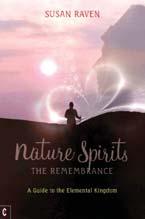 By Susan Raven
By Susan Raven
Available from BAA office – $30

This is an important book for humanity. I can hardly do a more positive critique than quote from the cover blurb.
“In this lucid, step-by-step guide, Susan Raven introduces us to the world of nature spirits and elemental beings, and why these entities wish to reconnect with us. By working together with the elementals—which reside in earth, water, air and fire—we can become responsible co-creators at this critical time in our evolution. The future of humanity, and that of the Earth, may be dependant upon such a positive and reciprocal relationship.
“Susan investigates the nature of the accelerated, evolutionary wave of consciousness pulsing into Earth at the present time, and how its effects are helping us to forge a new link with the spiritual and etheric worlds. It is in the ether—where the dissolving and coalescing forces behind physical matter exist—that we find the kingdom of the nature spirits. Making use of her personal experiences, Susan describes the activities of these beings in the landscape, in plants and in human beings. She presents meditations and exercises to prepare us for a meeting with the nature spirits, and emphasises the importance of working with the elemental kingdom in our immediate environment.
“The path of personal development outlined in Nature Spirits: The Remembrance features a wide range of insightful testimony from some of the most well-respected seers, with particular emphasis on the work of Rudolf Steiner.”

As if all this isn’t enough, the following I feel has a compelling message for us all.
“To consciously participate in the affairs and rhythms of Earth and cosmos must now become a fixed objective for humanity. We can prepare ourselves for this conscious participation by building a sensitive and appreciative relationship with the background generative presence behind the sense-perceptible world.”
The following list is presented for consideration by members. The Board and staff of BAA consider these titles provide a thorough and rounded basis of knowledge and information for any biodynamic practitioner. Most are held in stock (multiple copies) for sale at the BAA office, or if not can be ordered in at short notice.



RUDOLF STEINER BOOKS

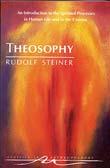
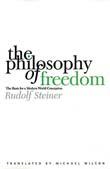
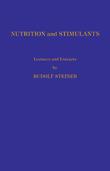


Recommended reading list Books can be purchased through the office
FURTHER
Agriculture Lectures Knowledge of Higher Worlds NutritionNutrition and Stimulants Occult Science: An Outline A Biodynamic Manual Pierre Masson Alternative Treatment for Ruminant Animals Paul Dettloff Biodynamic Treatment of Fruit Trees Berries and Shrubs Ehrenfried Pfeiffer Philosophy of Freedom, Basis for a Modern World Conception Theosophy Nature Spirits 51 Biodynamic Agriculture Australia Ltd ~ News Leaf #94 50 News Leaf #94 ~ Biodynamic Agriculture Australia Ltd
READING
Recommended reading list Books can be purchased through the office
Complete Herbal Handbook for Far and Stable

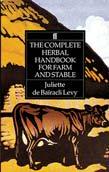
Juliette de Bairacli Levy
Foodwise Wendy Cook

Culture and Horticulture

Storl
Enlivened Rock Powders

Harvey Lisle
Paramagnetism
Philip Callahan
Results from the Biodynamic Sowing and Planting Calendar

Maria Thun
Secret Life of Plants
Peter Tompkins & Christopher Bird
Gardening for Life the Biodynamic Way
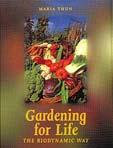
Maria Thun
Grasp the Nettle
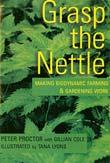
Peter Proctor
Secrets of the Soil

Peter Tompkins & Christopher Bird
Seeking Spirit Vision
Dennis Klocek
The Good Bug Book Australasian Biological Control Inc
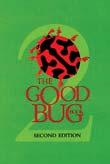
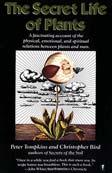
Homeopathy for the Herd Shaffer
How can I use Herbs in my Daily Life
Isabell Shipard
Living Water, Viktor Schauberger and the secrets of Natural Energy
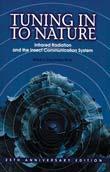

Olof Alexandersson
The Nature of Substance –Spirit and Matter

Rudolf Hauschka

Tuning into Nature
Philip Callahan
Weeds and What They Tell Ehrenfried Pfeiffer

Natural Cattle Care


Pat Colby
Natural Farming Pat Colby
Natural Goat Care
Pat Colby
The Antipodean 2013 Astro Calendar
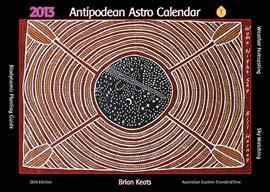
Brian Keats
Available from BAA office – $25 32 pages, A4, full colour.

Natural Horse Care
Pat Colby
Natural Sheep Care Pat Colby
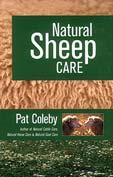

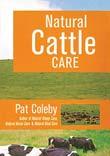

Nitrate An Ailing Organism Calls for Healing

H H Koepf
MAIL ORDER BOOKS
Postage rates vary depending on weight please see our website for information on shipping prices: http://biodynamics.net.au/products/shipping-information/ Remember when you renew your membership, and pre purchase the Astro Calendar, BAA pays for your postage.
53 Biodynamic Agriculture Australia Ltd ~ News Leaf #94 52 News Leaf #94 ~ Biodynamic Agriculture Australia Ltd
Biodynamic Agriculture Australia Ltd does not necessarily endorse the product or service being offered within advertisements.
News Leaf
MEMBERSHIP ~ SUBSCRIPTION
Biodynamic Agriculture Australia Ltd is a not-for-profit company limited by guarantee. We are a membership organisation supporting Australian farmers and gardeners to regenerate the land and produce quality food and fibre. Support our work by becoming a member of our organisation or subscribing to News Leaf.
News Leaf is the quarterly journal of Biodynamic Agriculture Australia Ltd and is available only by subscription. It is printed to coincide with the seasons of Autumn, Winter, Spring and Summer and covers a diverse range of topics for the commercial farmer, small holder and home gardener.
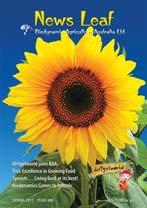

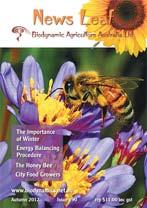
A mix of practical advice, farm and garden profiles, reports on both local and international biodynamic activities, nutrition and research as well as book reviews, information on the use of the planting calendar and reports on the making and use of the biodynamic preparations all help keep our readers informed and connected.
EcoProperty / EcoRealEstate
Property Selling, Renting, Leasing all around Australia
ORGANIC FARMS • ENERGY E FFICIENT HOMES IN CITY, TOWN, OR SUBURB BUSH CONSERVATION • ECO VILLAGES AND COHO USING • ECO TOURISM LAND FOR TRANSITION TO ORGANICS AND BIODYNAMICS
LIFESTYLE PROPERTIES • ECO B USINESSES • LAND FOR HOUSING
EcoProperty Marketing Programs for Property Owners & Real Estate Agents

Specialist Agents and Dedicated Real Estate Services

EcoProperty Local Consultants all around Australia
National T: 1300 796 326 (local call from landline and some mobiles)
M & SMS: (61) 0409 528 692
e: ecoproperty@eco.com.au
www.eco.com.au www.ecoproperty.com
www.ecorealestate.com.au
Sydney; NSW | Melbourne; Victoria | Local and Regional Offices

Membership of our organisation is open to any group, farmer, gardener or any other individual wishing to support Biodynamic Agriculture, and is divided into three categories:
Farm membership $130 p/a* for farm and commercial enterprises (over 5ha)
Garden membership $65 p/a* for smallholders and home gardeners
News Leaf subscription only $44 p/a
Includes:
• News Leaf subscription
• Access to biodynamic preparations
• Advice, education and support
• Opportunity for diverse individuals to meet and share common interests
• Voting rights at AGMs
• Non Voting
* Farm and Garden membership subscriptions incur an additional one-off $15.00 administration fee.

For Membership and News Leaf subscription form (including gift subscription) www.biodynamics.net.au Ph: 02 6655 0566


55 Biodynamic Agriculture Australia Ltd ~ News Leaf #94 54 News Leaf #94 ~ Biodynamic Agriculture Australia Ltd
APPLICATION FOR SUBSCRIPTION / MEMBERSHIP
Membership type: Farm ($130 + $115) News Leaf Subscription ($44) Garden ($65 + $15)Gift News Leaf Subscription ($44)
Personal Details:
Name: ............................................................................................................................... ........................
Address:
Home Ph:............................................. Mob: ................................. Email:..............................................
How/Where did you hear about Biodynamic Agriculture Australia?
Business Details:
Trading name: ABN:
Farm Address: ............................................................................................................................... ..................................
Work Phone:
Size: haProducing / Processing
Broad Acre:

Dairy:
Fruit / Vegetables / Plants:
Wine Industry: Livestock: ............................................................................................................................... .............
I agree to be bound by the constitution of Biodynamic Agriculture Australia Ltd and apply to become a member.


Signature: Dated: 20
Recipient of Gift Subscription:
Name: Address: ............................................................................................................................... ..................................
Home Ph: Mob: Email:
Payment Details: I enclose my CHEQUE / MONEY ORDERfor $ OR Charge my VISA / MASTER CARD
Card Number: | | | |Exp. Date: /
Cardholder’s Name:
Signature:
Post to: Biodynamic Agriculture Australia Ltd, PO Box 54 Bellingen NSW 2454 or FAX TO: 02 6655 0565
Alternatively, call us on 02 6655 0566 to submit your membership application over the telephone.
Biodynamic Agriculture Australia Ltd does not necessarily endorse the product or service being offered within advertisements.
Simple, cost effective, large area application of the biodynamic remedies, remote peppering of weeds, animal and insect pests.

Locally built new by an Aussie farmer to the latest design – treat up to 4000 acres for cents per acre
Call for information or pricing
Setting up and Installation arranged at reasonable cost
LLOYD CHARLES 02 6955 3225 0429 444 152 lcharles@clearmail.com.au
HYDROGEN PEROXIDE 35% FOOD GRADE FOR FARM AND GARDEN AUSTRALIA’S BEST PRICE CONTACT: JAN GORONCY NTP HEALTH PRODUCTS PHONE: 02 4997 2530 Email: marketing@ntphealthproducts.com 57 Biodynamic Agriculture Australia Ltd ~ News Leaf #94 56 News Leaf #94 ~ Biodynamic Agriculture Australia Ltd
H2O2
Biodynamic Preparations & Products List

Prices as at September 2012. All prices include GST. Please arrange credit card payment at time of ordering. Preparations & Products are packed and posted within 3 working days of receiving each order.
BIODYNAMIC PREPARATIONS
includes Horn Manure 500, Horn Silica 501, 502-507, Equisetum 508, Horn Clay and Horn Basalt, Basalt Dust
includes Horn Manure 500, Manure Concentrate, Winter Horn Clay and Fermented 508
Cow Manure, Preps 502, 503, 504, 505, 506, 507 Ground Egg Shells, Basalt Dust Winter Horn Clay for soil or Summer Horn Clay for atmosphere
OTHER PRODUCTS
Garden Kit small 1 portion each of Combined Soil up to 1 acre Preparation, Horn Silica 501, Summer
included Horn Clay, Fresh Equisetum 508 and
Home Garden Kit large As above with Hectare Portions of up to 1 hectare Combined Soil Preparation, Horn Silica & Instructions included Summer Horn Clay, Fresh Equisetum 508 and 1 Large Set of Compost
LIQUID PRODUCTS
Portion size Non Member Home Garden Farmer Horn Manure500 35gm $8.25 $5.50 85gm/ha $18.15 $12.10 $7.70 1kg $130.50 $87.00 >10kg/kg $82.00 Horn Silica501 1gm $7.20 $4.80 2gm/ha $13.20 $8.80 $5.00 100gm $315.00 $210.00 Biodynamic Soil Activator 30gm $6.00 75gm/ha $17.00 $11.00 $7.00 1kg $127.50 $85.00 Combined Soil Preparation 100gm $20.25 $13.50 245gm/ha $37.50 $25.00 $16.00 1kg $90.00 $60.00 Manure Concentrate Cow Pat Pit (CPP) 60gm $6.75 $4.50 150gm/ha $13.50 $9.00 $7.50 1kg $67.50 $45.00 Horn Clay 4gm $3.30 $2.20 10gm/ha $7.50 $5.00 $2.20 100gm $30.00 $20.00 Horn Basalt 1gm $2.70 $1.80 2gm/ha $4.50 $3.00 $2.00 100gm $105.00 $70.00 Dried Equisetum Arvense makes 10 litres concentrate 100gm $22.50 $15.00 $15.00 Fermented Equisetum 508 8X (soil) 5ml vial (up to 25ha) $6.75 $4.50 $4.50 Fresh Equisetum 508 8X (atmospheric) 5ml vial (up to 25ha) $6.75 $4.50 $4.50 Compost Preparations 502-507 Small set (up to 3 tons or 12m3 material) 1gm/prep $25.50 $17.00 $14.00 Large set (up to 6 tons or 24m3 material) 2gm/prep $45.00 $30.00 $24.70 Bulk set (up to 30 tons or 120m3 material) 10gm/prep $165.00 $110.00 Valerian 507 5ml $8.25 $5.50 $5.50 100ml $25.00 Manure Concentrate Compost preparations for Preparations 1 wheelbarrow of manure – 4gm of each prep $75.00 $50.00 $50.00 MC Preps with Eggshell Manure Concentrate kit and Basalt Dust + eggshell & basalt dust $82.50 $55.00 $55.00 Ground Eggshell (for MC) 200gm $6.75 $4.50 $4.50 Basalt Dust (for MC) 400gm $7.50 $5.00 $5.00 5kg $16.00 $11.00 $10.00 20kg $48.00 $32.00 $27.00
Portion size Non Member Home Garden Farmer Compost Preparations in 1gm Small Set in 100gm balls $97.50 $65.00 $65.00 Manure Concentrate Balls 2gm Large Set in 100gm balls $112.50 $80.00 4gm Manure Concentrate Set in 200gm balls $157.50 $105.00
small
Preparations $52.50 $35.00
$82.50 $55.00 Diatomaceous Earth 20kg bag $172.50 $115.00 $115.00 1kg $10.50 $7.00 $7.00
Home
Instructions
1
set of Compost
Preparations
Biodynamic Fish 1 litre $15.00 $10.00 $10.00 Concentrate 2.5 litres $27.00 $18.00 $18.00 5 litres $52.50 $35.00 $35.00 20 kg (net19 litres liquid) $172.50 $115.00 $115.00 200 litres $1350.00 $900.00 $900.00 1000 litres $6000.00 $4000.00 $4000.00 Biodynamic Seaweed 1 litre $15.80 $10.50 $10.50 Concentrate 2.5 litres $34.50 $23.00 $23.00 5 litres $58.80 $39.00 $39.00 20 kg (net19 litres liquid) $195.00 $130.00 $130.00 200 litres $1500.00 $1000.00 $1000.00 1000 litres $6750.00 $4500.00 $4500.00 Biodynamic Combined 1 litre $17.30 $11.50 $11.50 Fish Seaweed Concentrate 2.5 litres $37.50 $25.00 $25.00 5 litres $60.00 $40.00 $40.00 20 kg (net19 litres liquid) $202.50 $135.00 $135.00 200 litres $1650.00 $1100.00 $1100.00 1000 litres $7500.00 $5000.00 $5000.00 Biodynamic Paste 5 kg $45.00 $30.00 $30.00 10 kg $75.00 $50.00 $50.00 20 kg $120.00 $80.00 $80.00 Nozzles for 500 5kph / 8kph / 12kph / 15kph $82.50 $55.00 $55.00 Nozzles for 501 Small / Large $72.00 $48.00 $48.00 Filter Bag 450mm long $55.50 $37.00 $37.00 18mm diameter, 400 micron 880mm long $84.00 $56.00 $56.00 Astro Calendar 2013 per 1 $25.00 $25.00 $25.00
59 Biodynamic Agriculture Australia Ltd ~ News Leaf #94 58 News Leaf #94 ~ Biodynamic Agriculture Australia Ltd new product new product new product new product
Postage is sent via Regular mail unless otherwise arranged when ordering. Liquid Products are sent via Post/Freight. 200lt and greater are sent at the most economic rate as arranged with customer.
www sites…
We have a new range of websites for you in this edition and hope to bring you new places to source interesting information in each edition. If you have a website you think others should know about please drop the News Leaf Editor a line at bdnewsleaf@biodynamics.net.au
www.soilandhealth.org
Here you will find free e-books, on diverse topics such as holistic agriculture, holistic health and self-sufficient living.
www.bfa.com.au
Biological Farmers of Australia. Australian Certified Organic Standards.
www.scytheaustralia.com.au
A website dealing with scythes in Australia.
www.milkwoodpermaculture.com.au
Milkwood Permaculture provides education in Permaculture and Regenerative Agriculture.
http://www.biodynamiceducation.com/
The Biodynamic Education Centre is an international college offering a range of educational programs for biodynamic farming and gardening.
http://taruna.ac.nz/
The place to study Organics and Biodynamics in New Zealand.
Biodynamic Agriculture Australia Ltd
Your Company, Your Board…
Ray Unger, Chair (02) 6869 7635 rayunger@bigpond.com
Shane Joyce, Deputy Chair (07) 4993 1880 sjoyce1@bordernet.com.au
Ted Clarke, Treasurer ......................... (02) 6649 2132 .... tedpeggy1@gmail.com
Hugh Lovel, Director (02) 6779 1136 hugh.lovel9@bigpond.com
www.biodynamics.net.au
Our own website. It has been transformed and is updated regularly. Please take a look.
www.gardenate.com
Garden calendar to keep your kitchen garden growing—vegetables & herbs to sow & plant right now.
http://www.rsarchive.org/Books/
The Steiner book.
http://www.rudolfsteineraudio.com/writ tenimagebased.html
Rudolf Steiner Audio Books.
www.ofa.org.au
Organic Federation of Australia website. Directory of many Organic/Biodynamic farmers and products/contacts.

www.nasaa.com.au
The National Association for Sustainable Agriculture in Australia. NASAA certifies to Biodynamic and Organic Standards.
Carolyn Ditchfield, Director (02) 6721 5111 carolyn@fromthesoilup.com.au
Kym Green, Director 0407 619 002 kjgreen@adam.com.au
Geoff Bassett, Director ....................... (02) 6721 4653 .... geoffbassett@live.com.au
Louise Skidmore, Secretary (07) 4697 3148 lskidmore@aapt.net.au
An accountable, transparent and consultative Board will ensure that it has good policies and procedures in place so that all decisions are made fairly and transparently. This will help remove any perceptions that Board processes are carried out in undue secrecy or that things are being hidden…
Using the website to publish information about your Company and the Board:
•The minutes of each board meeting are published on our website: http://www.biodynamics.net.au
•Board members’ Disclosure and Conflict of Interest declarations are on the website,
•Financial Statements are available on the website,
•Privacy compliant procedure to enable members to contact members.
Practical measures that the Board has put in place to ensure your Company becomes more consultative with a diversity strategy to ensure that the views of members are adequately represented on the Board:
•Emails and letters circulated to Board members,
•Phone numbers of Board available if members want personal contact,
•Letters to the News Leaf Editor.
Maintaining a communications strategy to ensure that Board decisions are explained and widely known:
•Board Update in News Leaf,
•Letter from the Chair.
Seeking input from members when key decisions are being contemplated or a change in direction is being considered:
•Inviting members to join committees to make recommendations to the Board,
•AGM and National Conference.
61 Biodynamic Agriculture Australia Ltd ~ News Leaf #94
60 News Leaf #94 ~ Biodynamic Agriculture Australia Ltd
News Leaf NEEDS YOUR INPUT! Stories, Photos, Observations, Feedback
bdnewsleaf@biodynamics.net.au
“The earth and the kingdoms of nature have come about for the sake of the becoming of man, but we have left them behind. Now, we have developed self-consciousness, and our task is to take what we have learned, and use this gift to merge the above, the cosmos, and below, the earth, and to establish a spiritual identity between ourselves and our earthly environment.
In this we are exercising freedom. In olden times, a farmer was bound by nature, and only knew how to respond to the laws of nature. The new farmer must become a conscious actor, not a reactor. No outside law presses you to work with the preparations. The more we do it out of spiritual insight, the more we are able to do it out of personal freedom. The preparations are a gift to our freedom sphere, and Rudolf Steiner opened the gateway for us to realise this sphere.
Don’t bind yourself to a strict system. Be open to intuitions. Walk the farm. Listen, and rely on your own judgement.”
 Manfred Klett, past leader of the Agriculture Section at the Goetheanum,Dornach. From an article in Applied Biodynamics, no 69, 2009. Newsletter of the JPI, USA.
Manfred Klett, past leader of the Agriculture Section at the Goetheanum,Dornach. From an article in Applied Biodynamics, no 69, 2009. Newsletter of the JPI, USA.












 By Paul Taylor PhD
By Paul Taylor PhD
















 Inverted Drum method ~ Folke Günther
Inverted Drum method ~ Folke Günther






 By Barbara M.V. Scott
By Barbara M.V. Scott

 By Diane Watkin
By Diane Watkin



















 By Susan Raven
By Susan Raven

















































 Manfred Klett, past leader of the Agriculture Section at the Goetheanum,Dornach. From an article in Applied Biodynamics, no 69, 2009. Newsletter of the JPI, USA.
Manfred Klett, past leader of the Agriculture Section at the Goetheanum,Dornach. From an article in Applied Biodynamics, no 69, 2009. Newsletter of the JPI, USA.